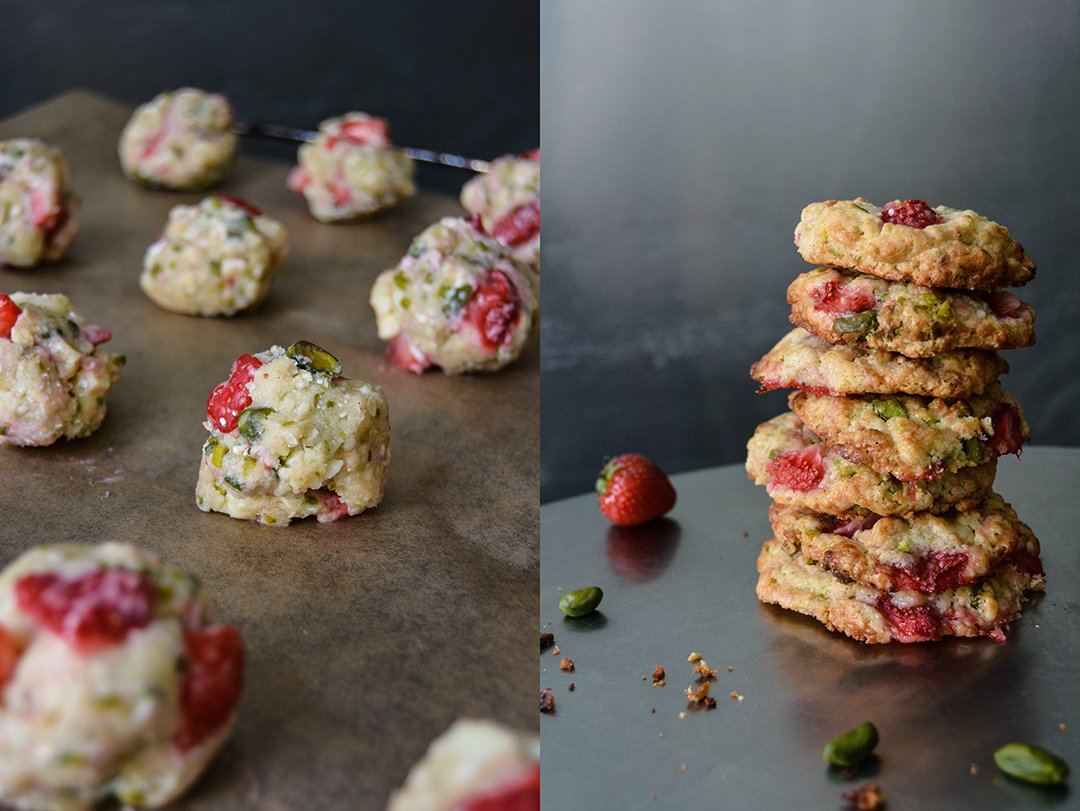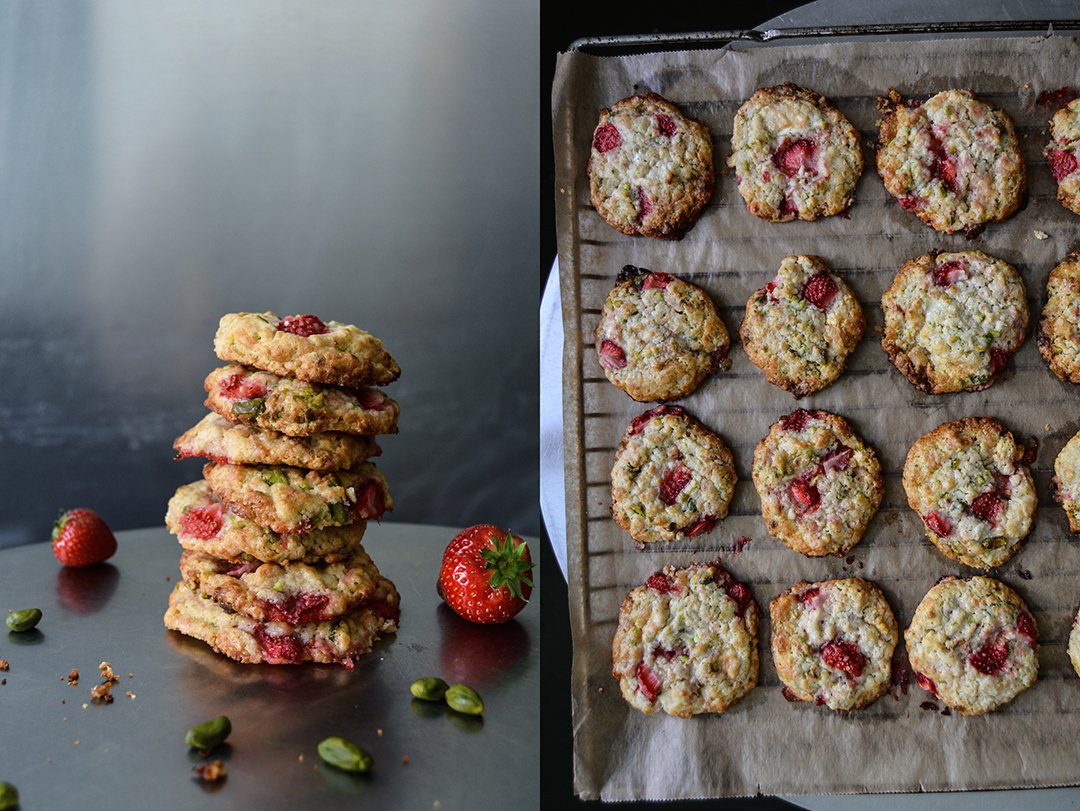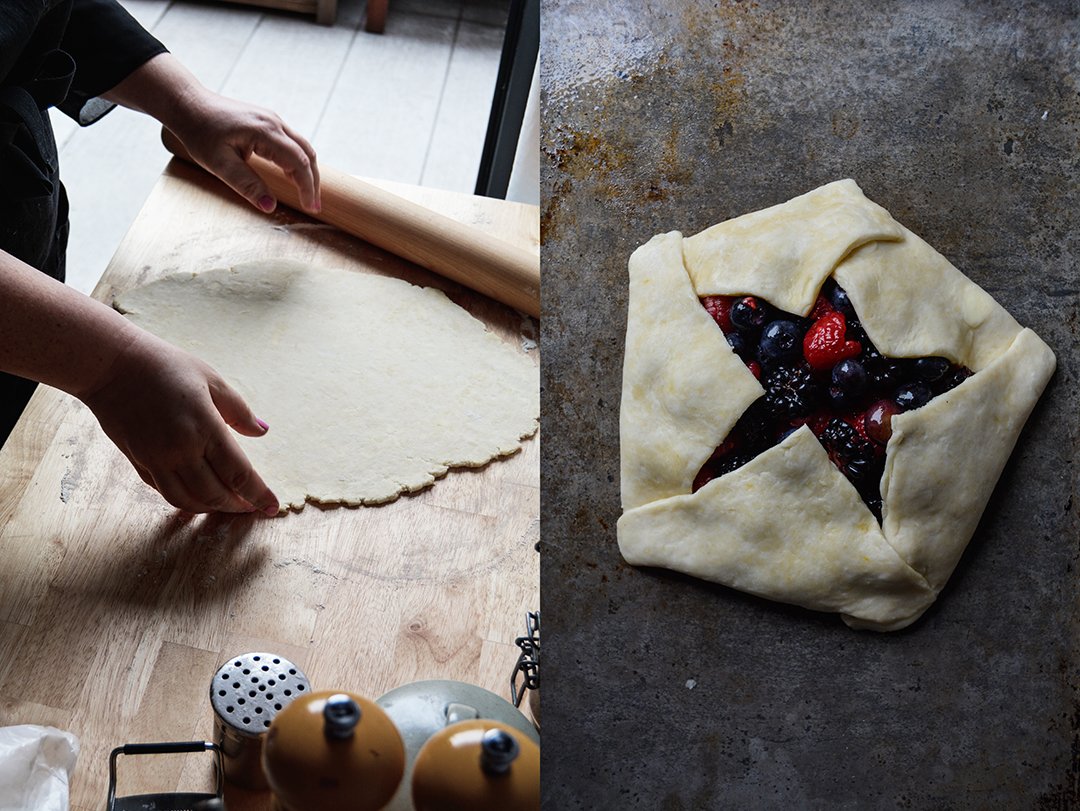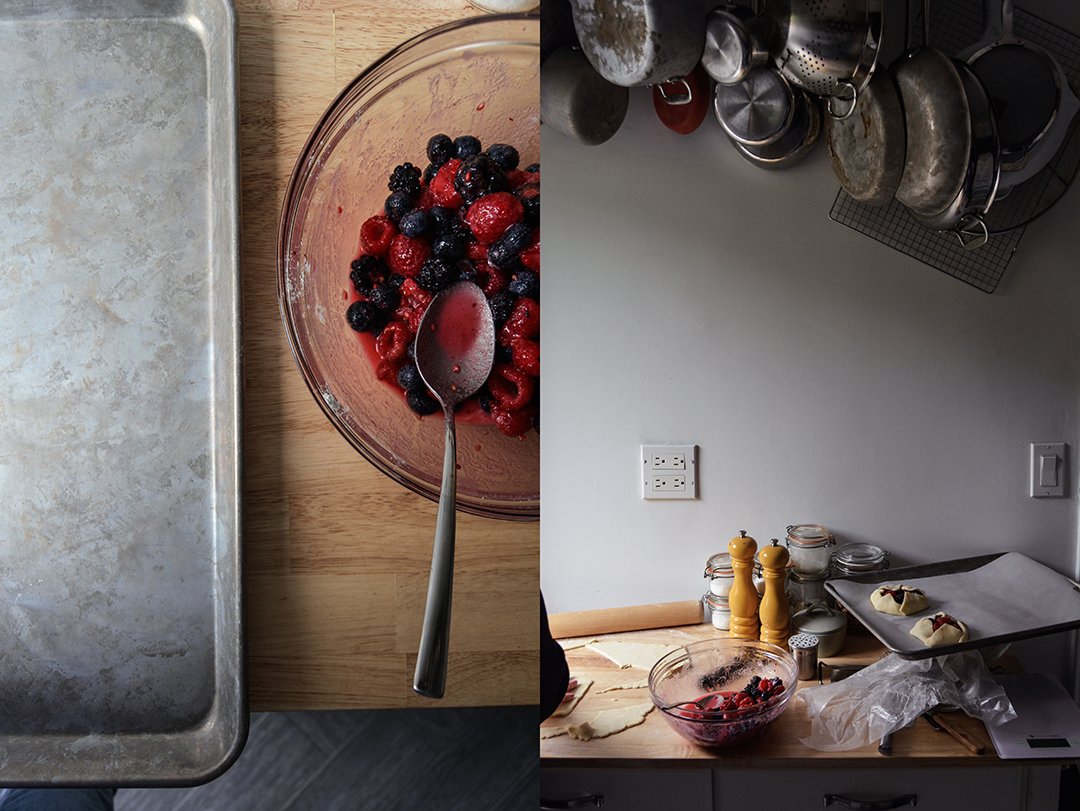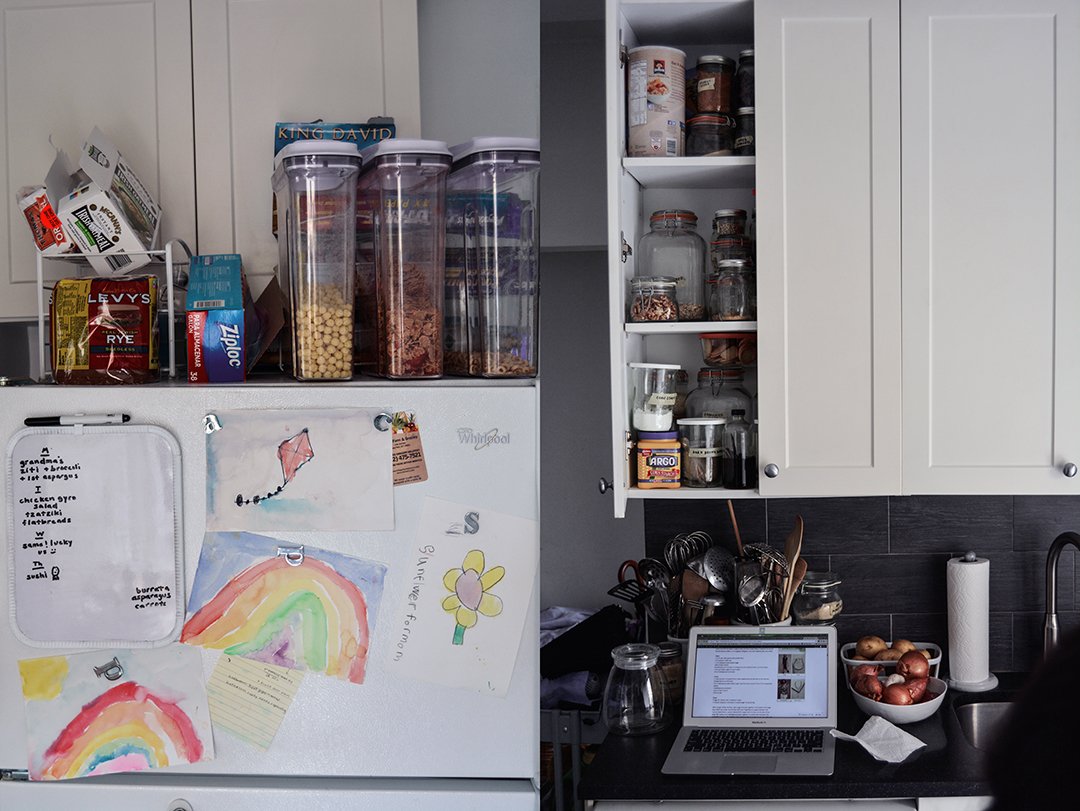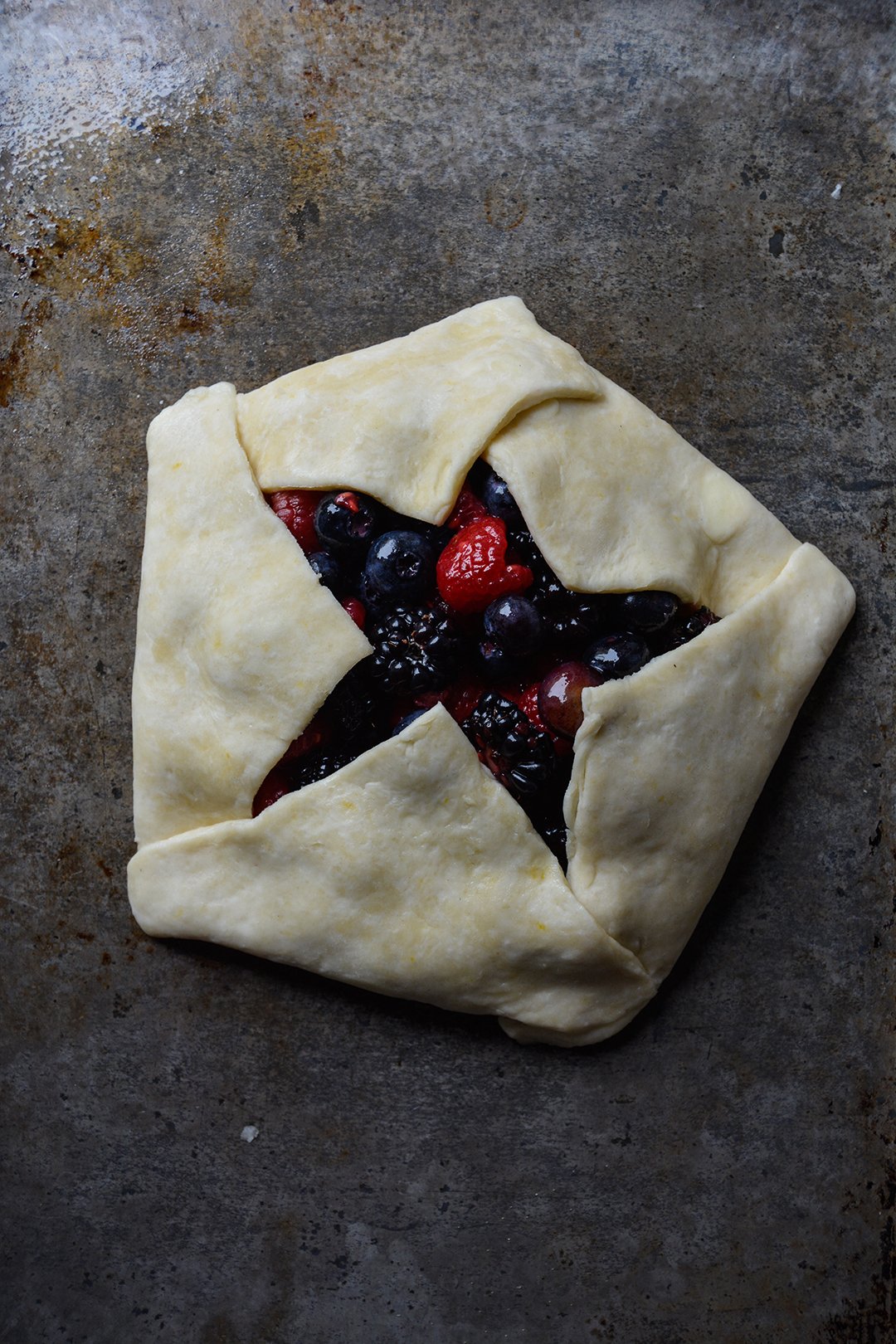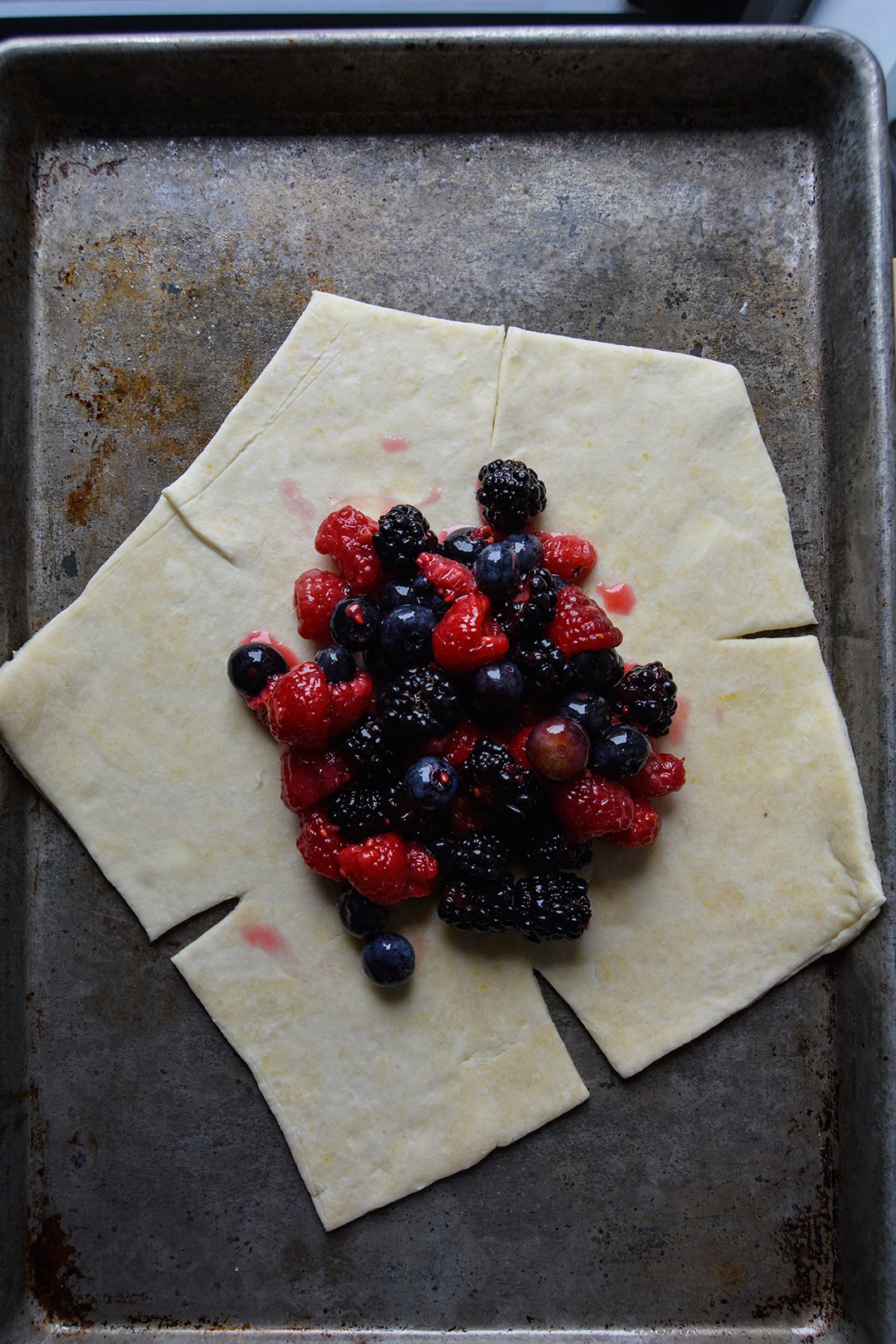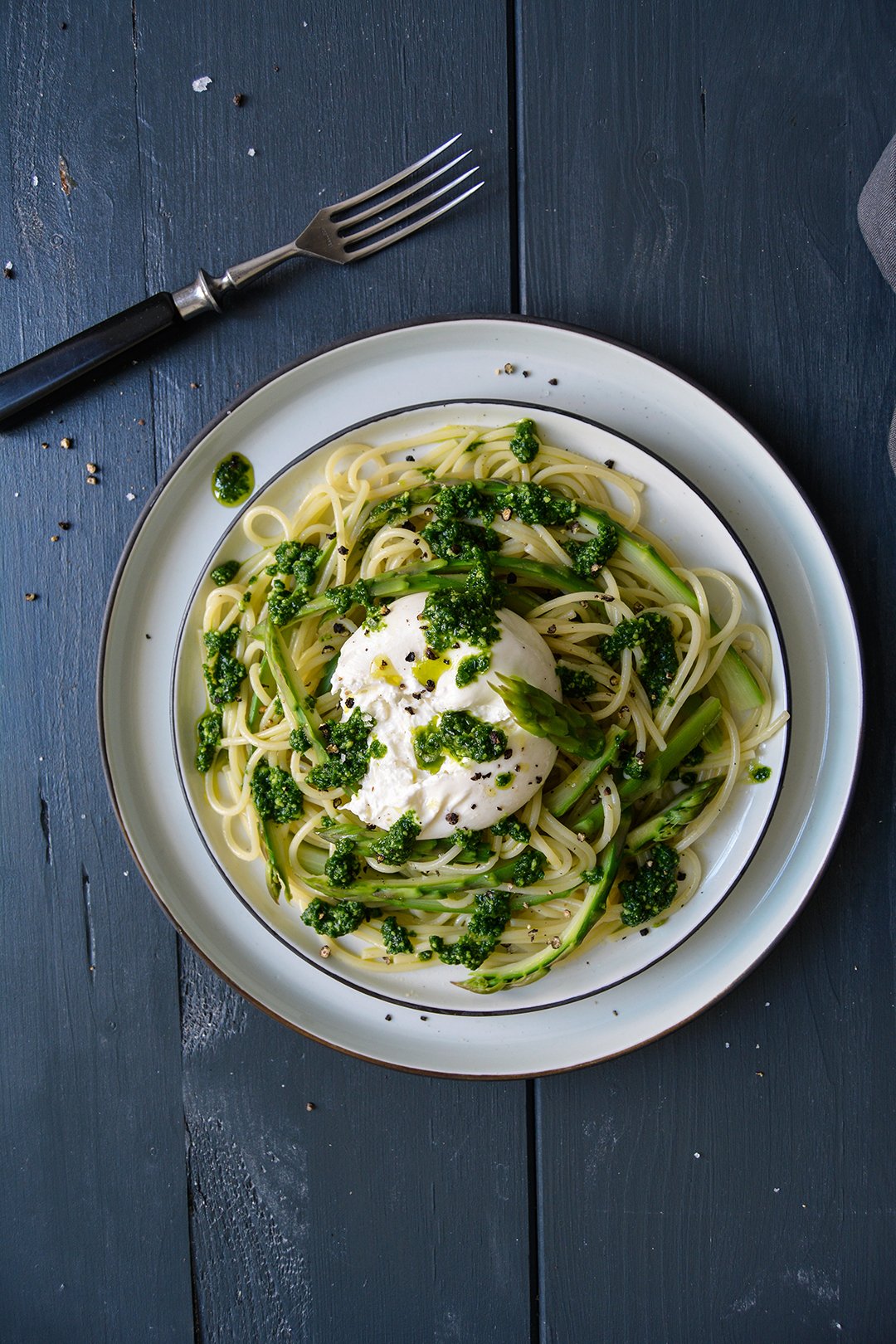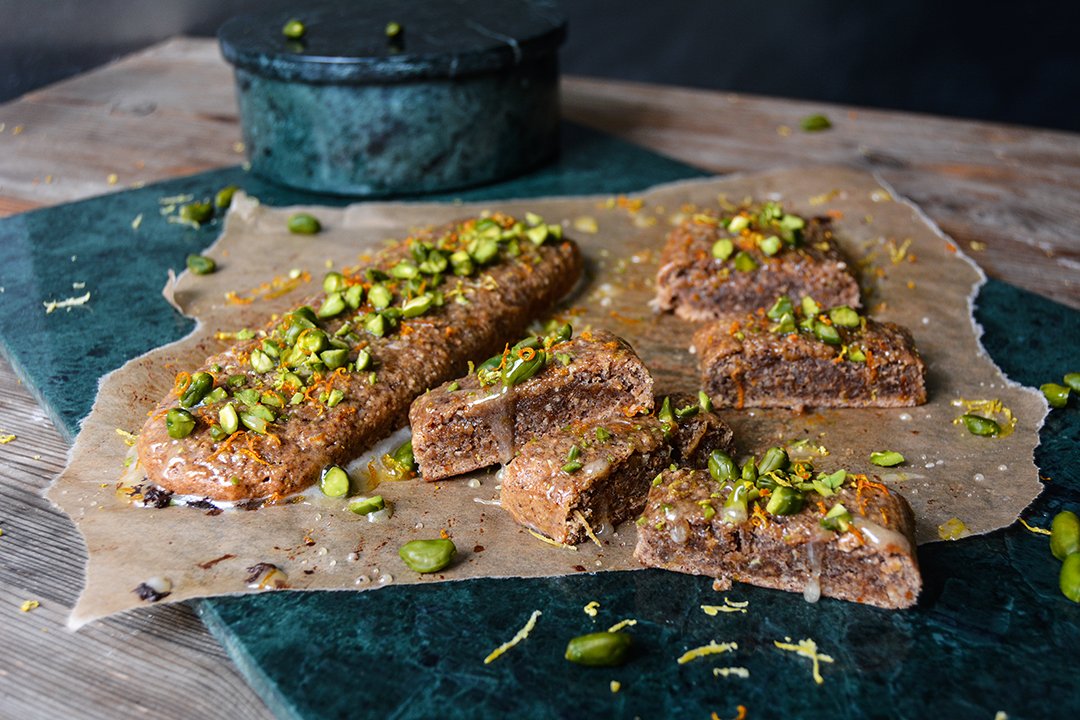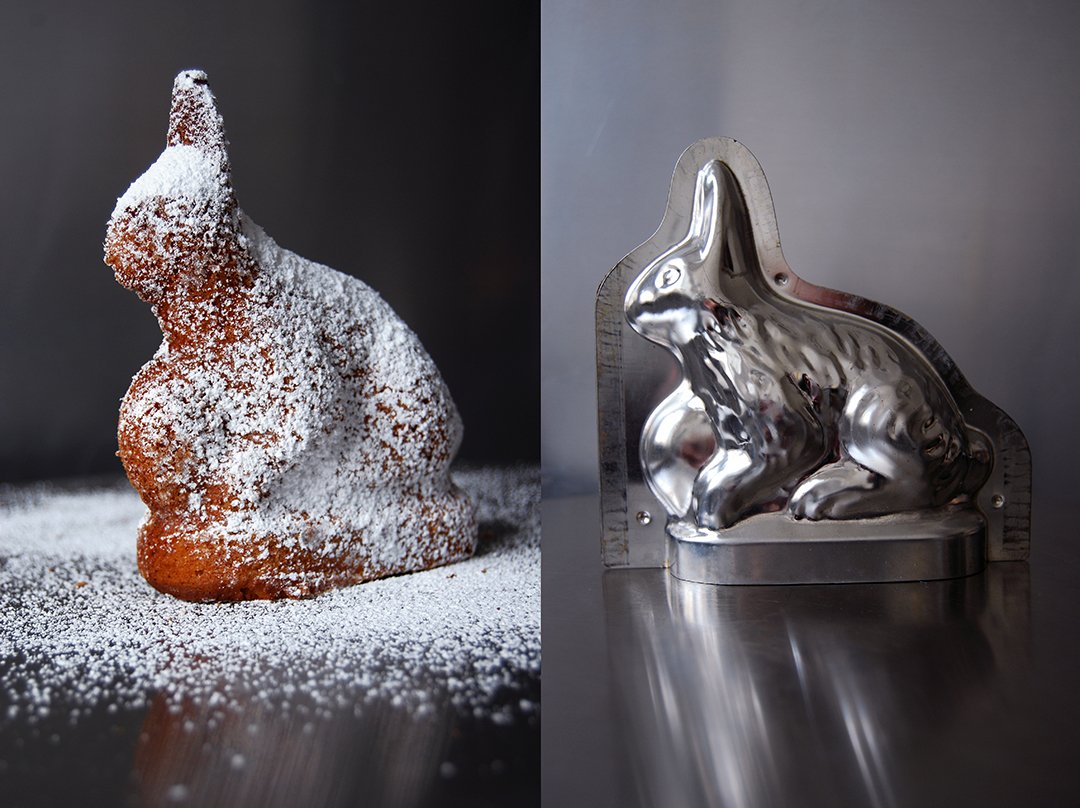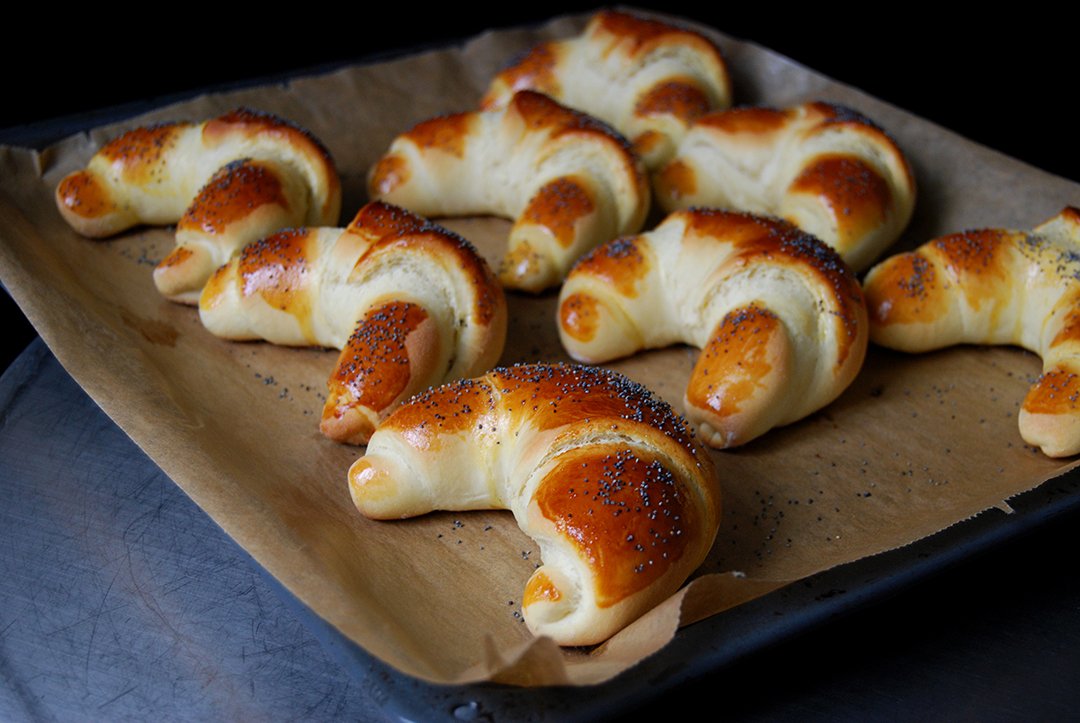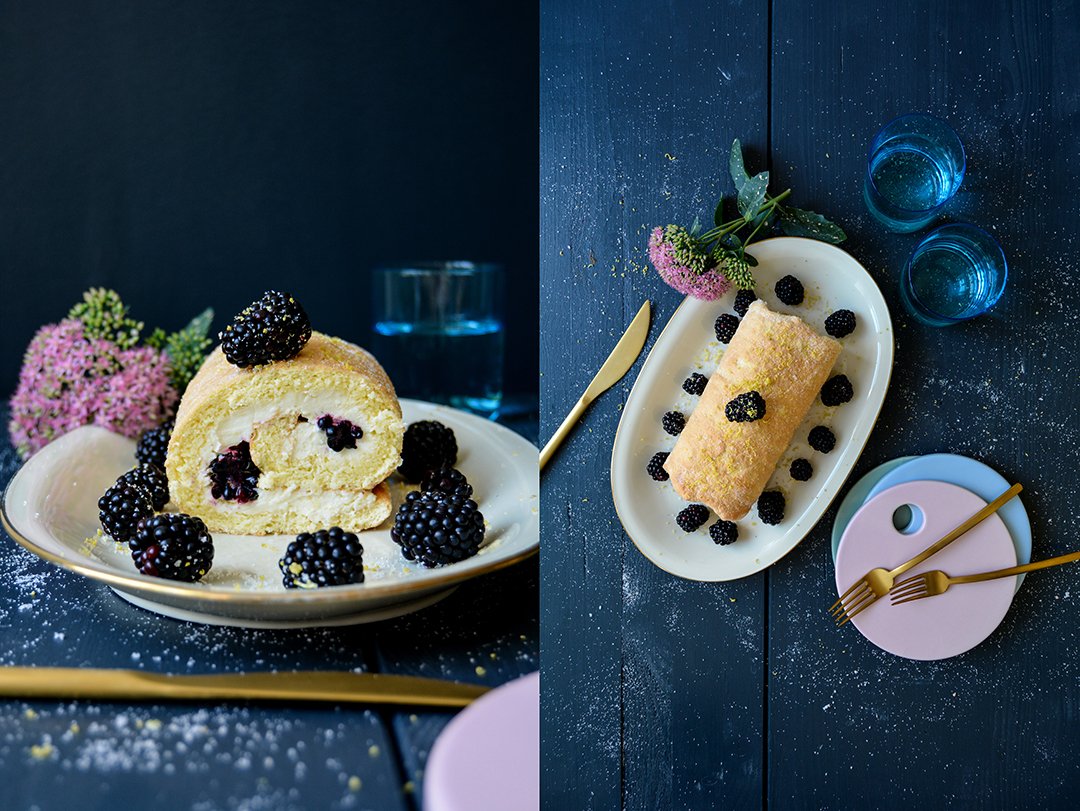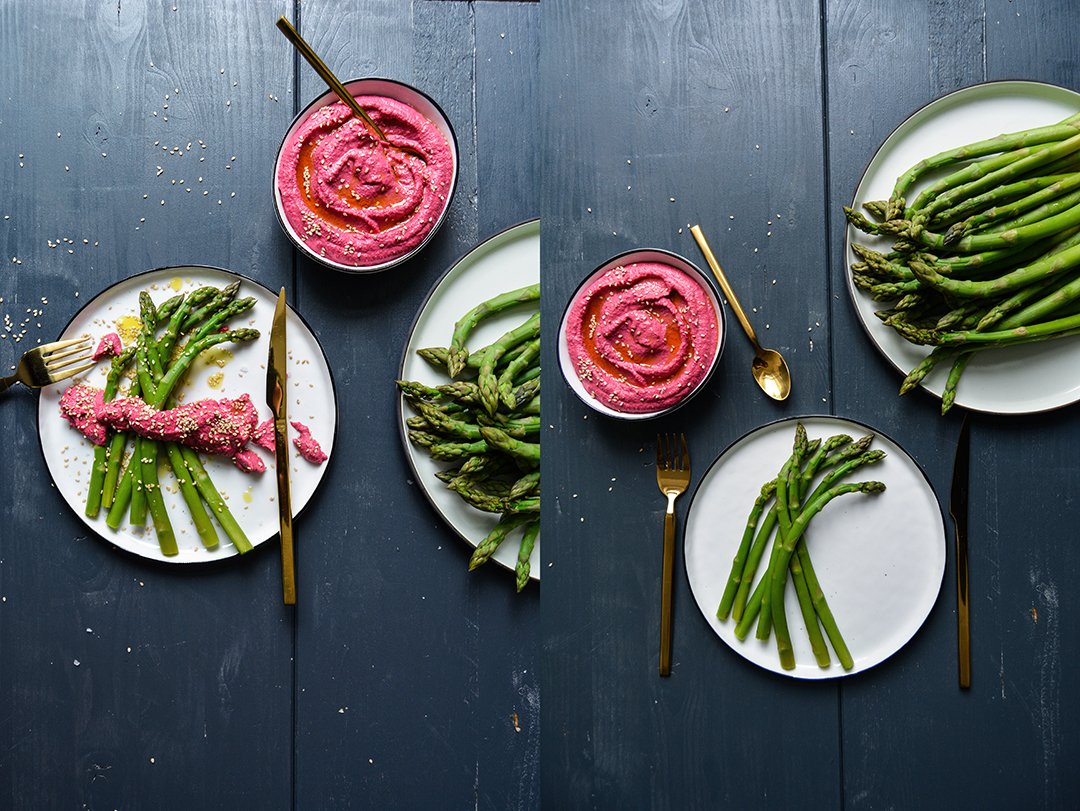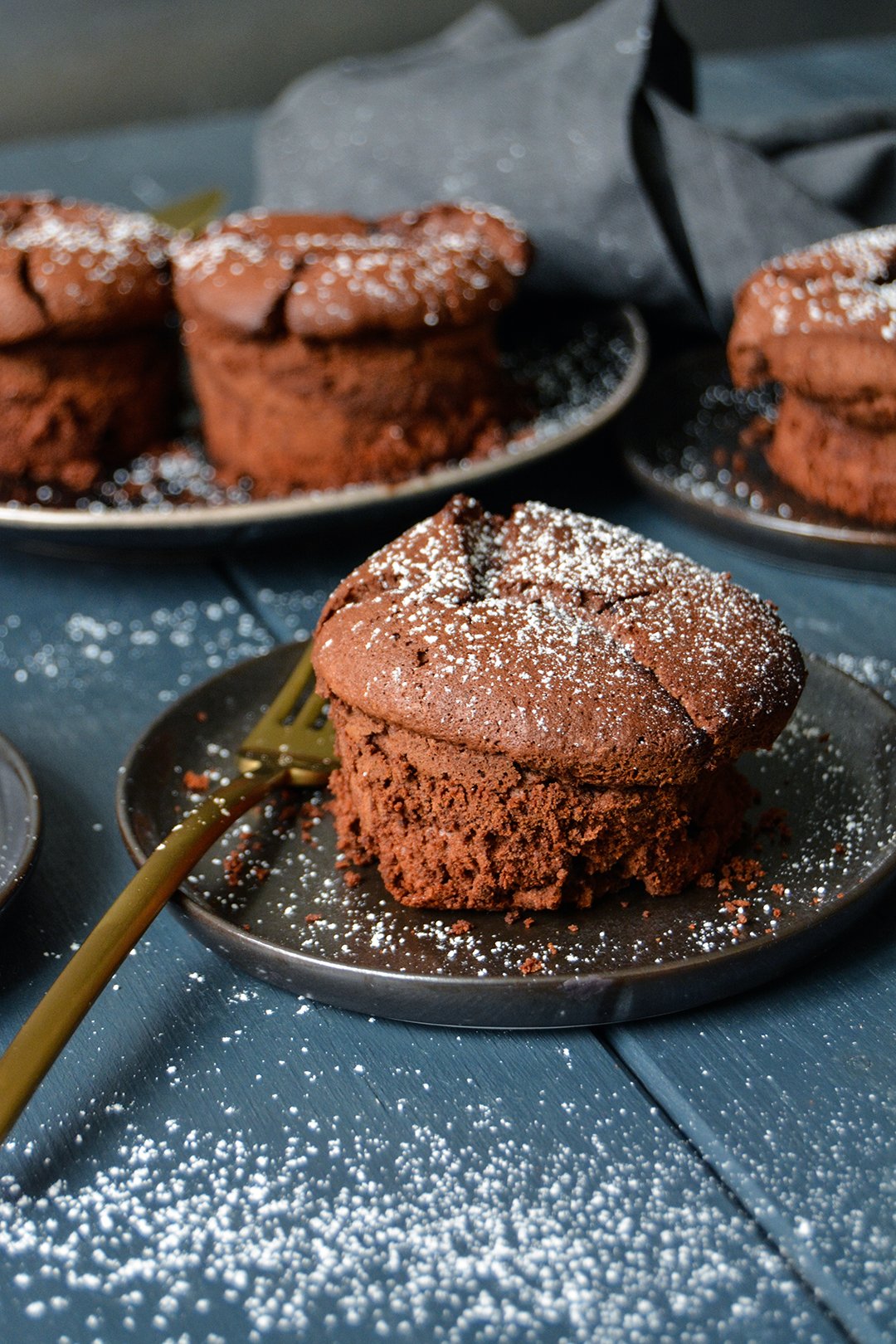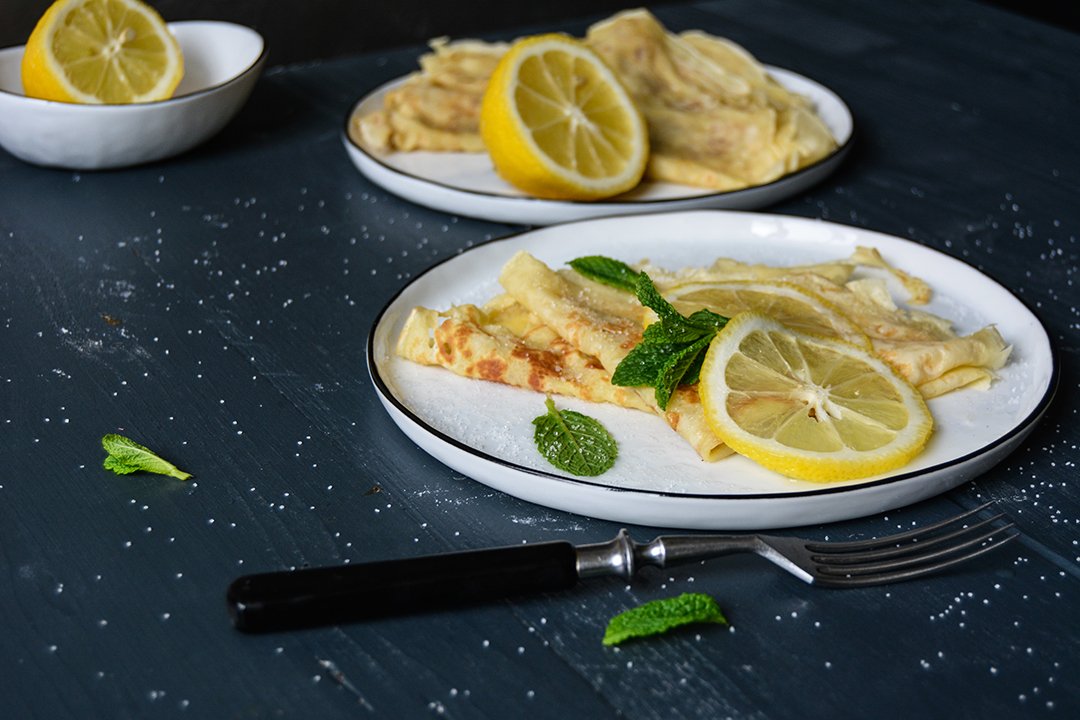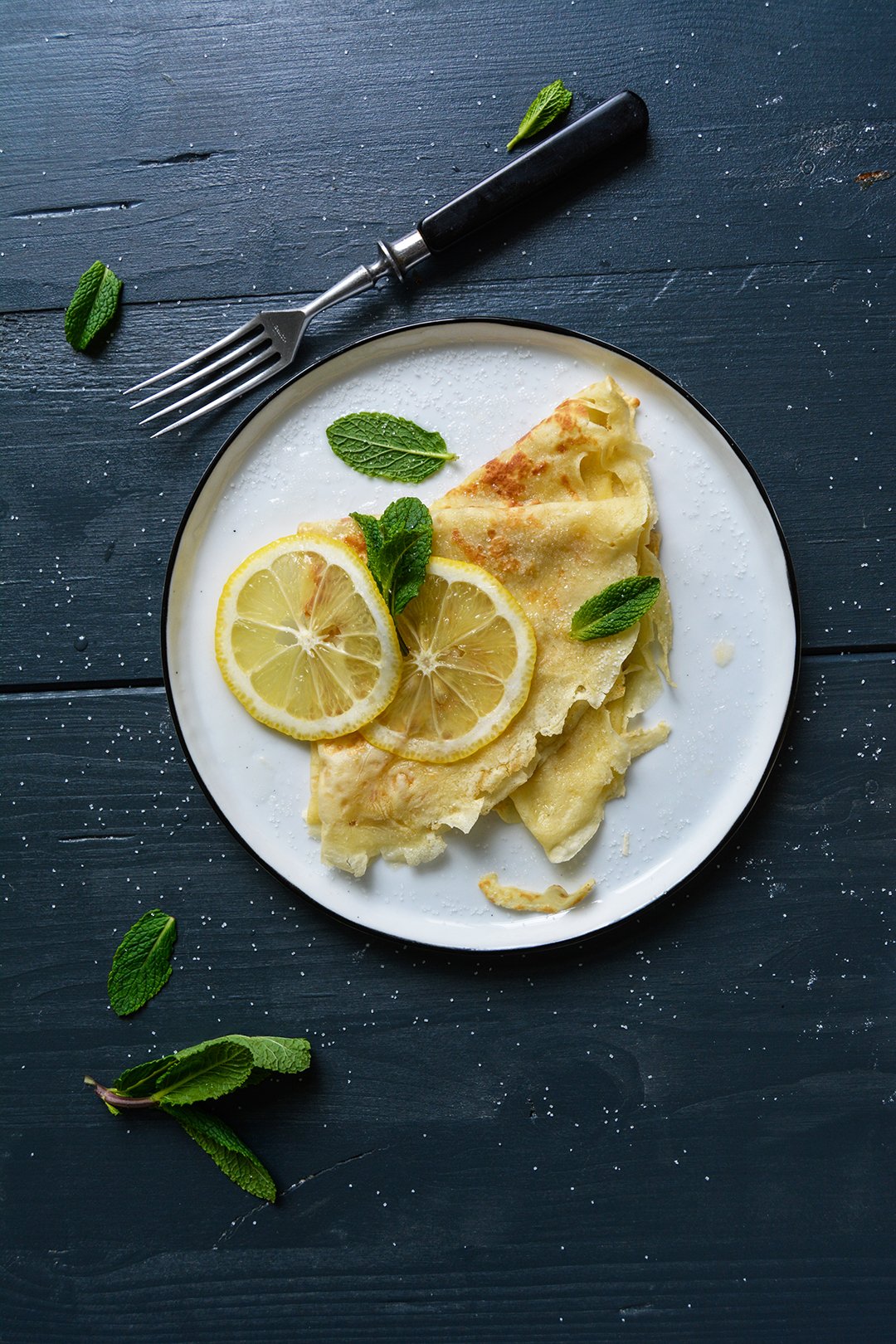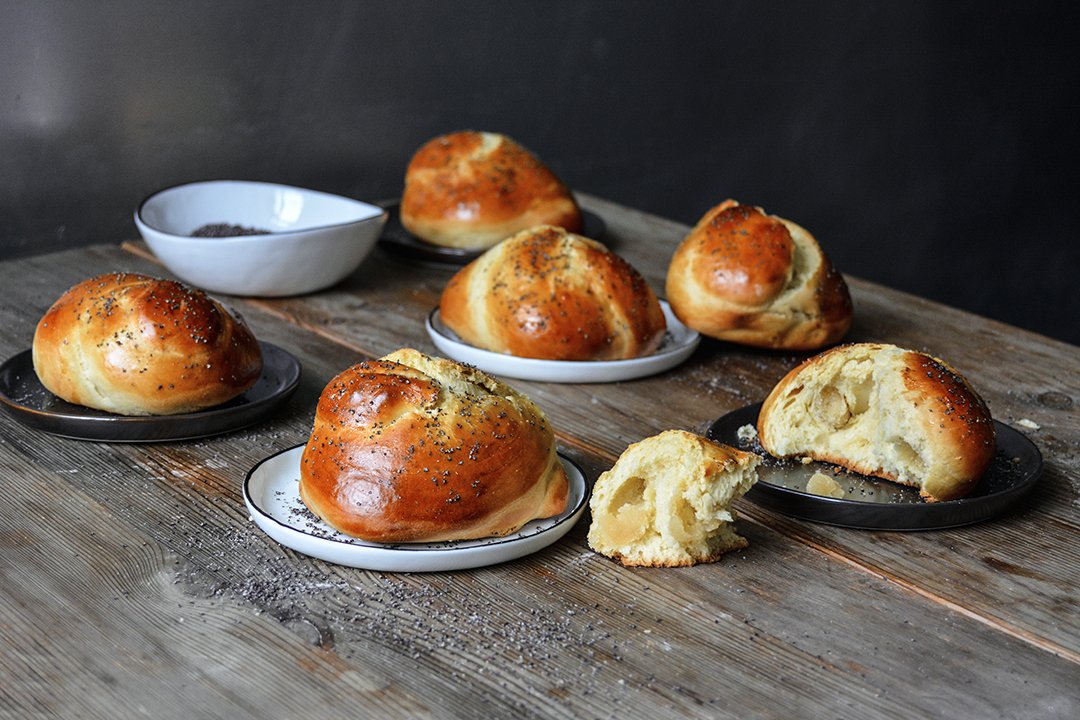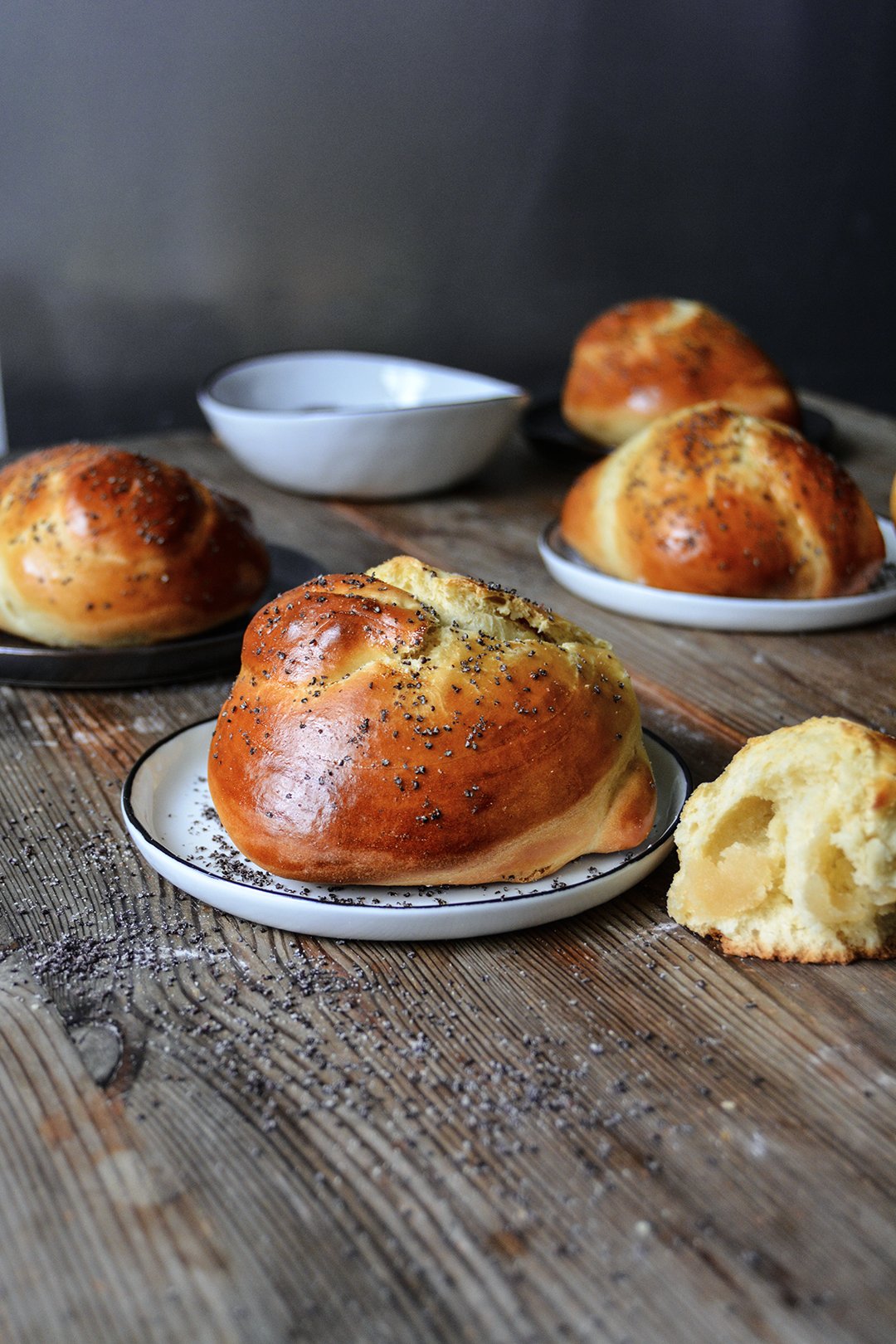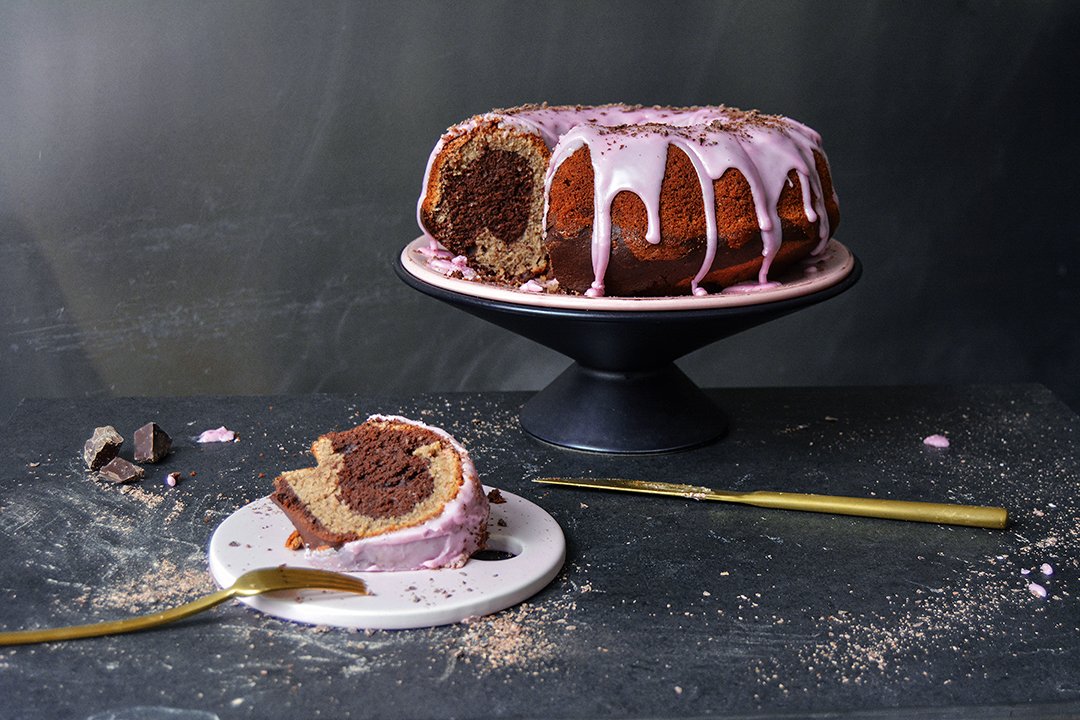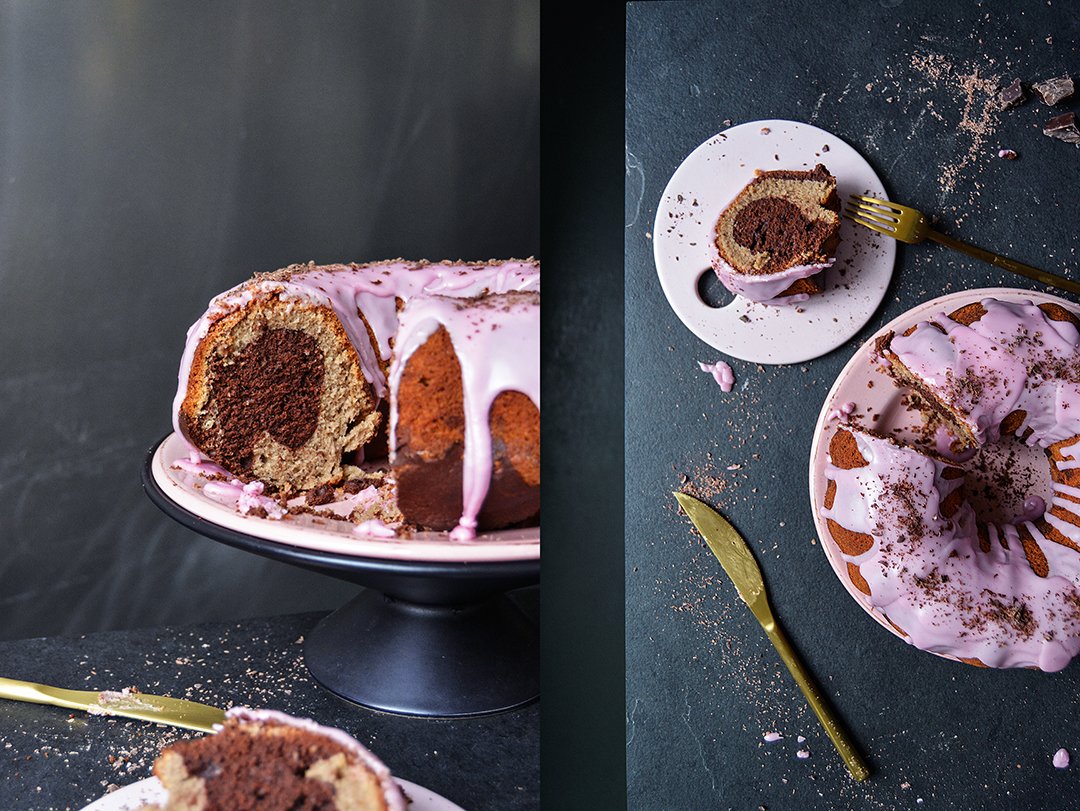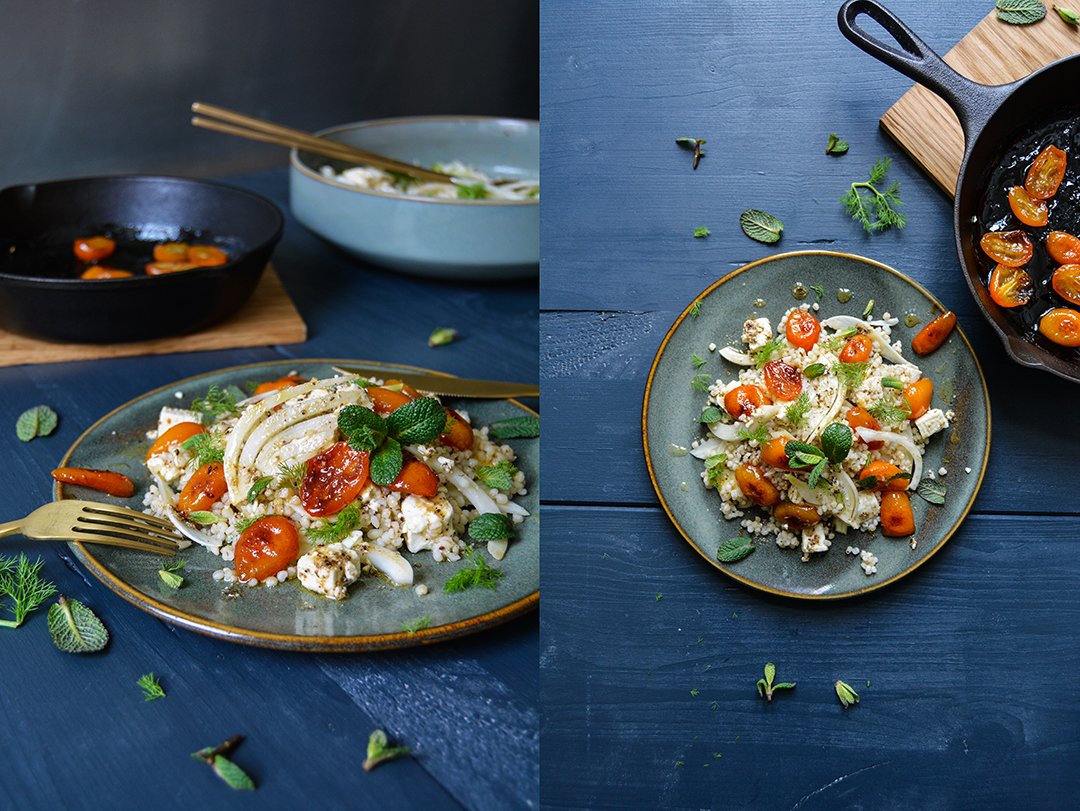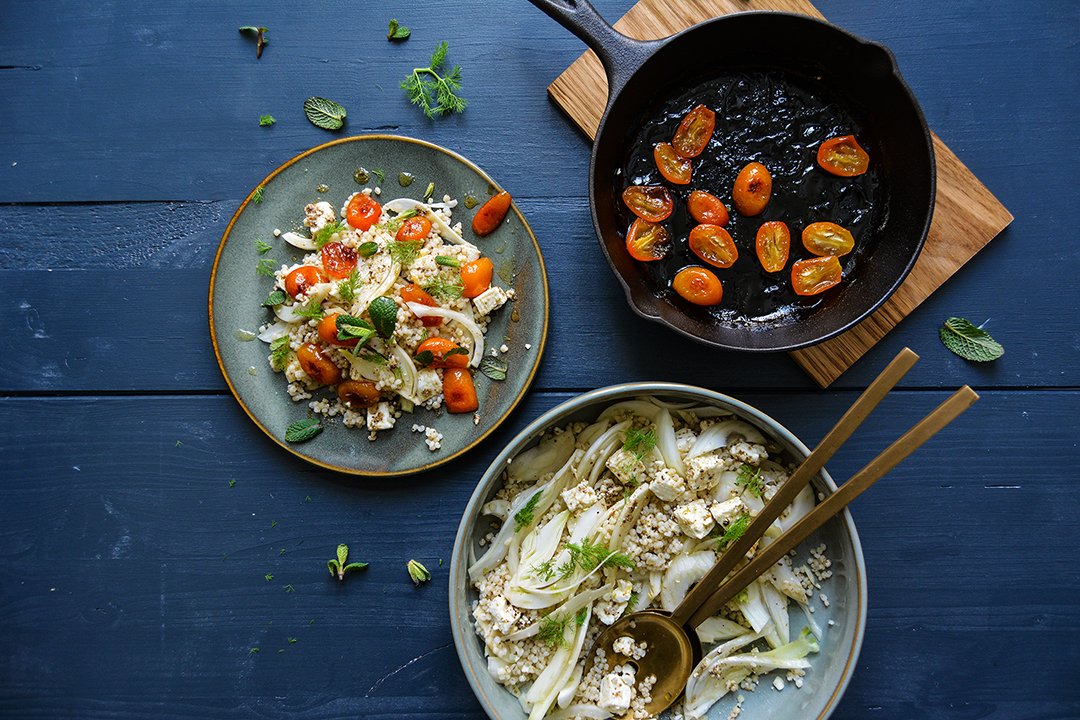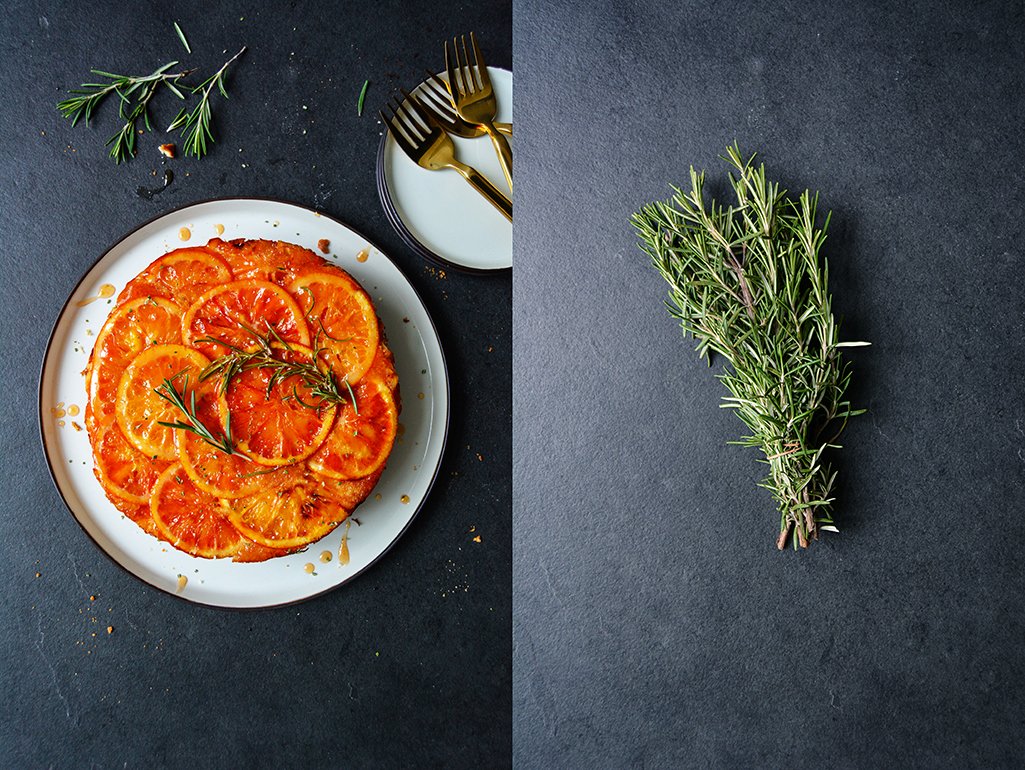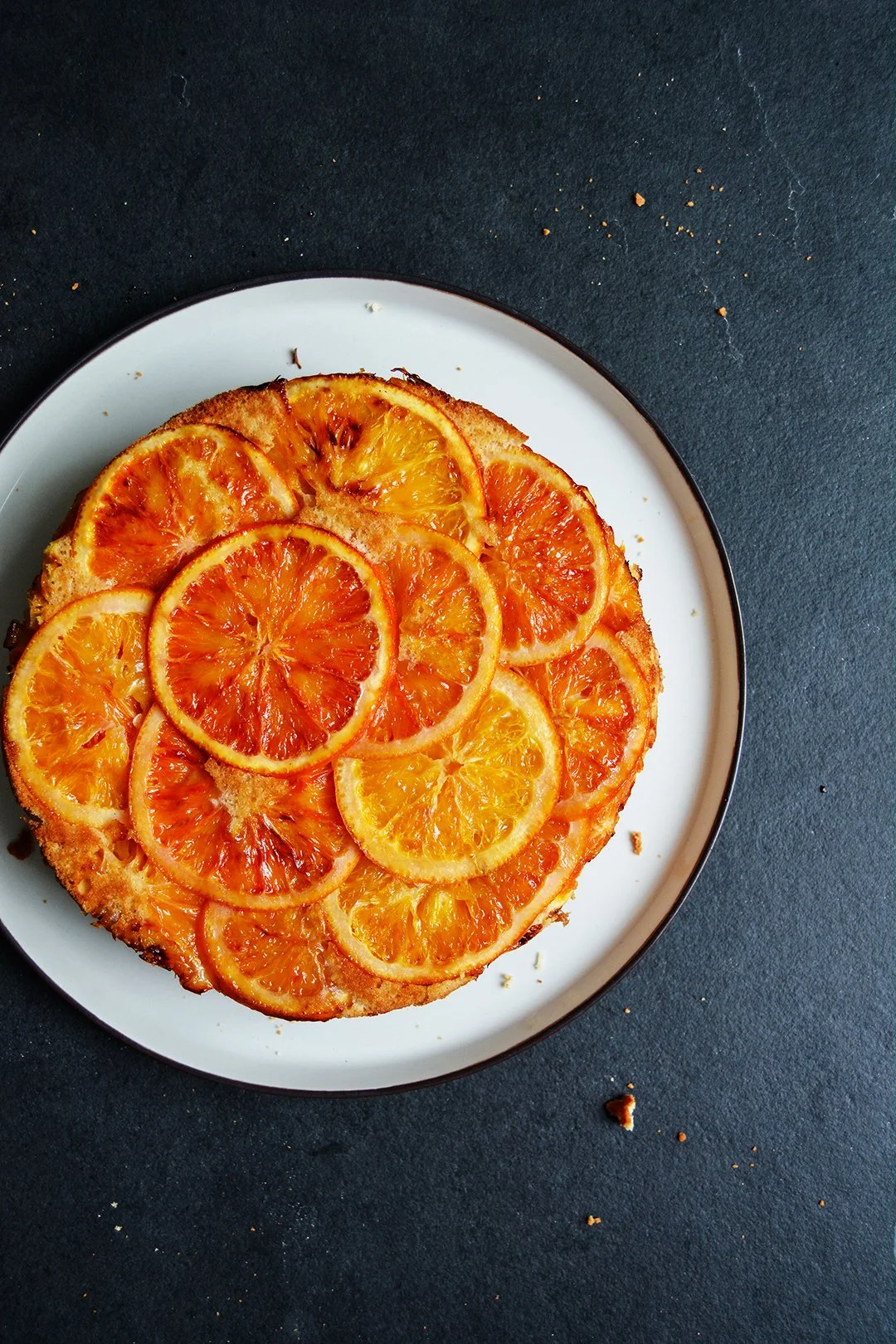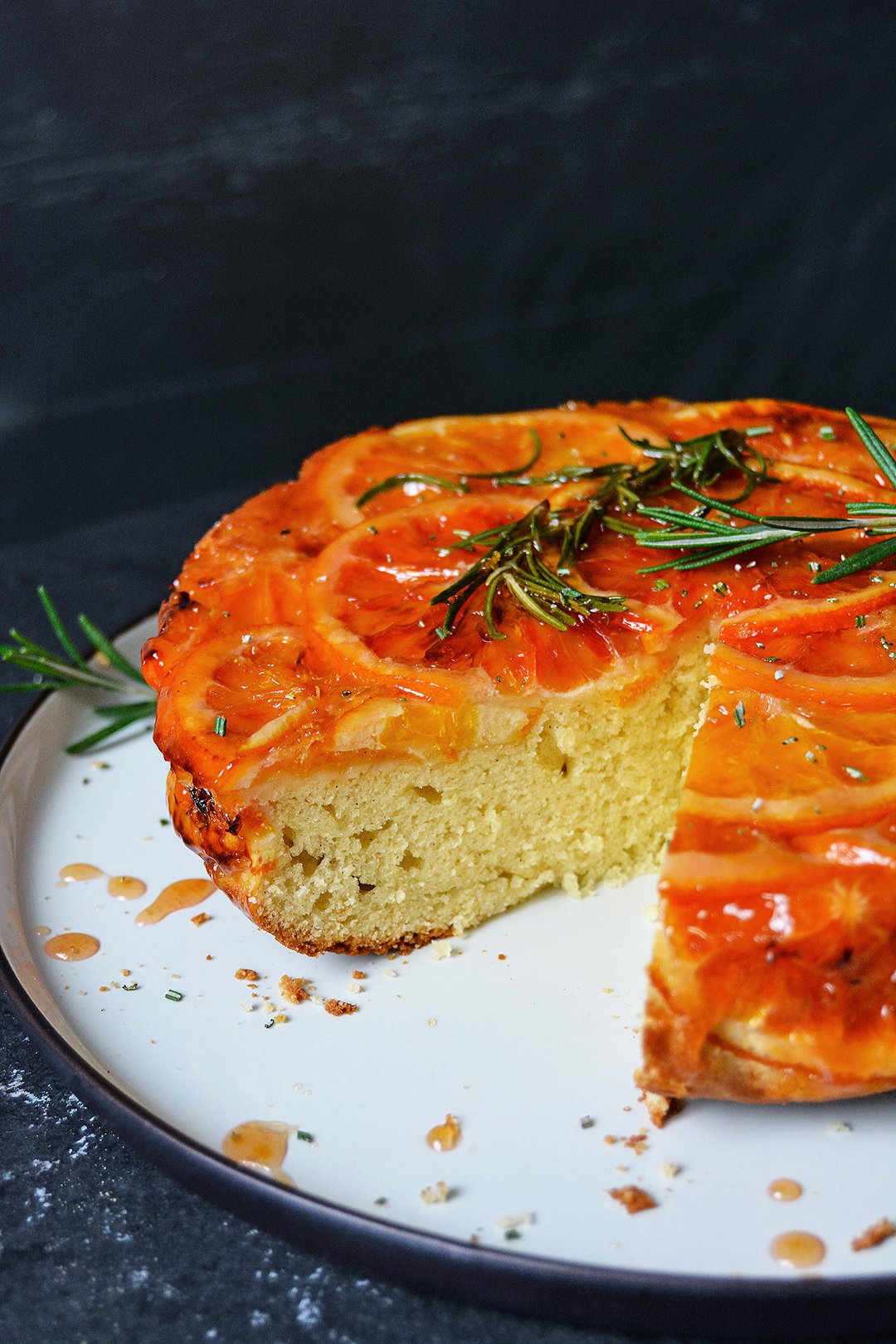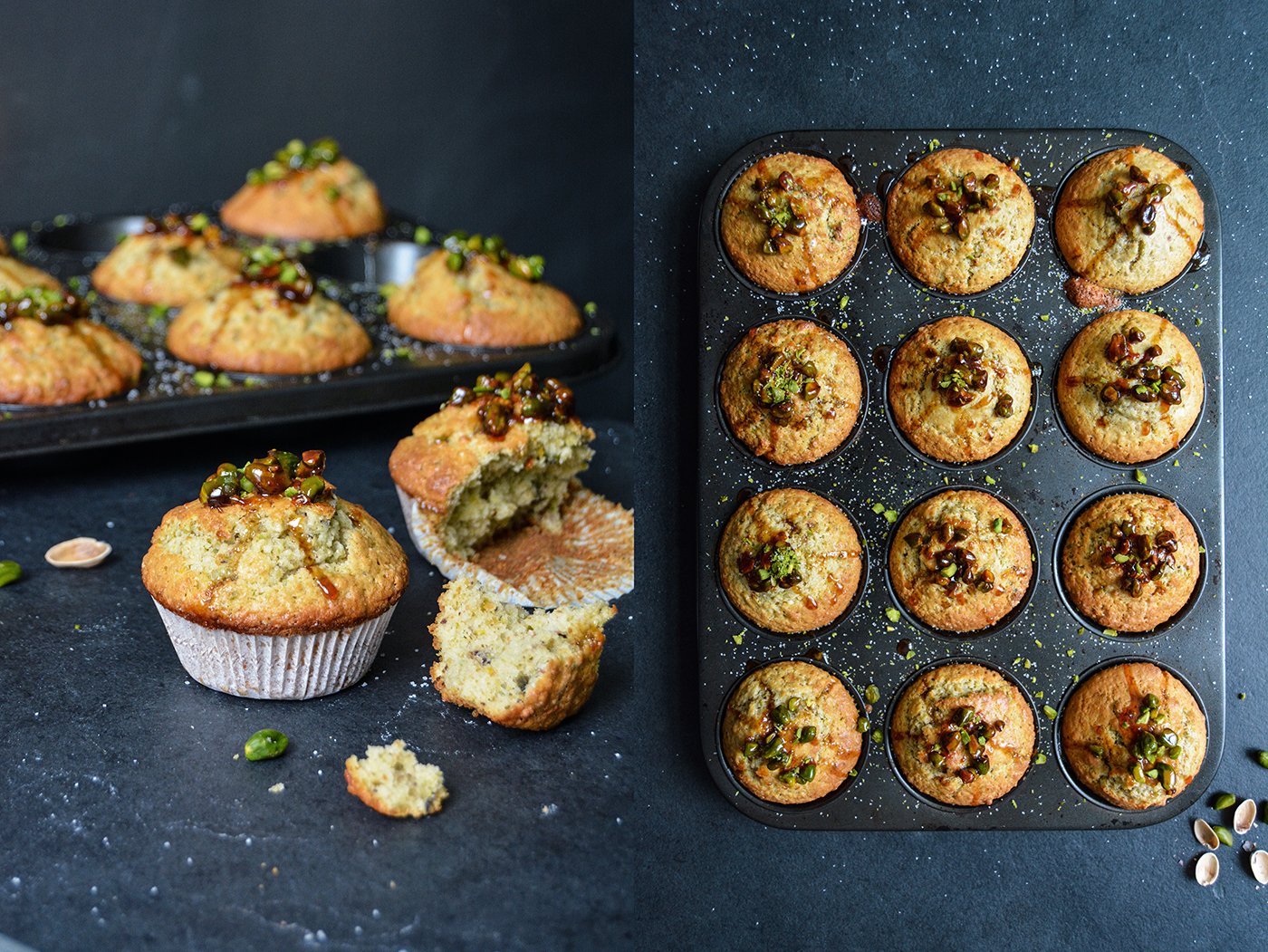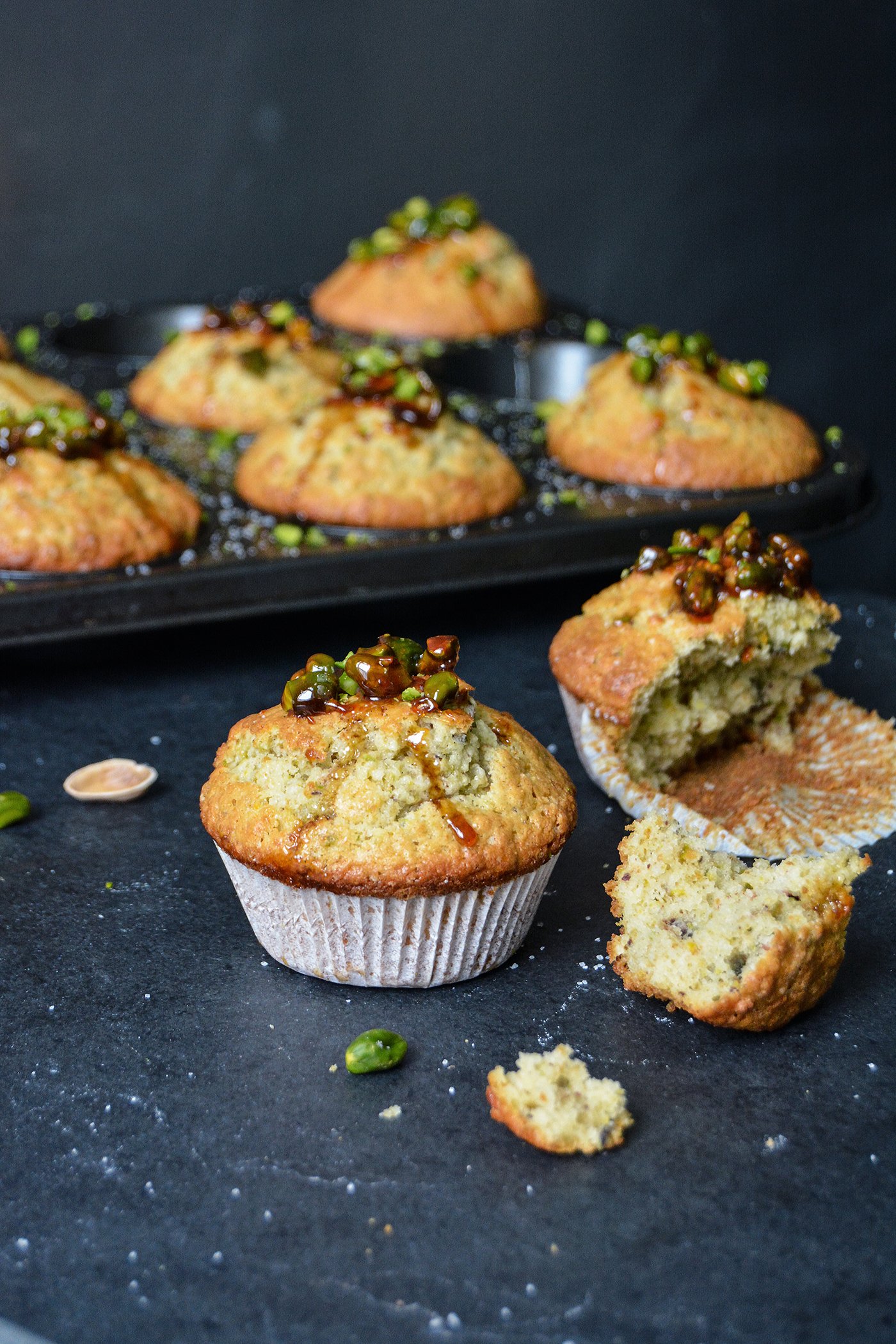Strawberry Pistachio Cookies with Oats and White Chocolate
This spring feels strange, it doesn't seem to start. Most of the time it's either too cold, too grey, or too wet, I'm more in the mood for cozy stews and hearty pies munched away on the sofa than the springy treats that I usually crave in May.
I'm impatient (not just in the kitchen), I tend to rush to the next season with hungry excitement. I find it hard to wait for the right ingredients to appear at the farmers' market for all the dishes that I already picture in my head. So, I guess I should be thankful for the unpleasant weather, it helps me to stick to the actual season - spring with a wintery touch. Unfortunately, the unusual frosty temperatures at night are a tough burden for the farmers. Their produce suffers, which narrows their harvest dramatically. The white German asparagus that I tasted wasn't as thick and tasty as in the past years, strawberries - by far - aren't as sweet. It reminds me that we're in nature's hands. It's an important reminder, showing us that we live in a fragile system that we easily tend to forget about.
Although I'm not too impressed by the strawberries' taste, they are totally fine in a cookie. Accompanied by nutty pistachios, smooth white chocolate, and a handful of oats, I turned them into the best cookies that my kitchen has seen in a while. They are sweet, soft, and so addictive. Have a bite, close your eyes and you can feel summer.
Strawberry Pistachio Cookies with Oats and White Chocolate
Makes about 20 cookies
plain flour 200g / 1 1/2 cups
rolled oats 50g / 1/2 cup
fine sea salt 1/2 teaspoon
baking powder 1 teaspoon
butter (soft) 130g / 1/2 cup
granulated sugar 150g / 3/4 cup
vanilla pod, scraped, 1/4
organic egg 1
white chocolate, roughly chopped, 100g / 3 1/2 ounces
unsalted shelled pistachios, roughly chopped, a small handful
fresh strawberries, ripe but not soft, cut into small pieces, 100g / 3 1/2 ounces
Set the oven to 175°C / 350°F (preferably convection oven) and line 2 baking sheets with parchment paper.
Take 1 heaped tablespoon off the flour and set aside.
In a medium bowl, combine the remaining flour, oats, salt, and baking powder.
In the bowl of a stand mixer, fitted with the whisk attachment, beat the butter, sugar, vanilla, and egg for a few minutes or until fluffy. Add the egg and continue mixing for about 1 minute until well combined. Using a wooden spoon, stir in the flour mixture until just combined. Fold in the white chocolate and pistachios.
This will make it easier to mix in the strawberries: Sprinkle and mix the strawberries with the heaped tablespoon of flour. Crumble and spread the dough on a baking sheet. Spread the floured strawberries on top of the dough and, using your fingers, gently (!) fold in the berries. Don't worry if it looks loose and messy, mind not to squeeze the berries too much. Scoop out a heaped tablespoon of dough for each cookie and gentle form a ball slightly smaller than a golf ball. Spread the dough balls on a dish that's safe to keep in the freezer, then put the cookies in the freezer for 10-15 minutes or until hard but not frozen. Spread the cookies on the 2 lined baking sheets, mind to leave enough space between the cookies, they will expand in the oven.
Bake, one baking sheet at a time, for about 13-15 minutes or until golden but still slightly soft. After 5 minutes, using a fork, flatten the cookies softly. Let them cool on the baking sheet for a few minutes before you transfer them onto a wire rack.
Meet In Your Kitchen | Deb Perelman - Smitten Kitchen's Berry Ricotta Galette
Last week I went to New York and I had three wishes on my mind:
1. I wanted to win the James Beard Award (I had strong doubts that that would happen).
2. I wanted to eat oysters at The John Dory.
3. I was hoping that Deb Perelman would open the doors to her famous Smitten Kitchen for a Meet In Your Kitchen feature.
And what can I say, I was a lucky girl. I won the award, I had a fantastic pre-award oyster treat just for myself (if you like oysters, book a table at April's restaurant next time you visit NYC!) - and I met and baked together with Deb!
Smitten Kitchen was the only blog I knew about when I started Eat In My Kitchen in November 2013. I discovered many more in the past three years, but not many managed to keep my attention with such persistence as Deb's. She knows how to entertain, impress, and inspire me with calm ease. Her love for food jumps out of all of her recipes, out of every picture she takes and every line she writes. She's a perfectionist, but she knows how to hide it. She's a charmer.
Deb's blog is a staple in the blog world. She started in 2003 writing about her life in general and focussing on recipes since 2006. When you ask yourself how a single person can build up such a successful food platform on her own and keep it running like a smooth motor, you just have to meet her and you'll know why. Deb is full of life and energy, at the same time down to earth and humble. She's not interested in the blunt surface, in superficial attention, she wants to explore a recipe in depth and present it in all its glory. And here lies her secret: all her recipes make sense, from a cook (or baker) and an eater's point of you. She calls herself a fussy eater, picky like her children, she doesn't mind baking the same cake 14 times until it's just right. This leads to a habit of excessive note taking whenever she's at the cooker. To learn, to improve, and to develop the right formula that she and her readers can totally trust. This trust is what a food blog is built on. Mrs. Perelman takes this task quite easily as she loves what she does, she only cooks the food that she craves herself and that she's curious about. She's like a passionate scientist, working late at night, while everyone else is already in bed, and she's still there, solving culinary problems.
Her journey into and in the kitchen was influenced by her work at a bakery as a teenage girl, by her family with roots in Germany and Russia, Jewish baking, and American cooking. Her mother's cookbook by Julia Child added some French extravagance to the palate and sparked her interest. When you read Deb's blog, you can see that she has a weak spot for comfort food. She might be a fussy eater but she's not into fussy cooking.
After hundreds of recipes developed by herself and shared online, it was time, in 2012, to turn this treasure into a physical publication. When Deb's first cookbook - The Smitten Kitchen Cookbook: Recipes and Wisdom from an Obsessive Home Cook - entered the book shops, it happened anything but quietly. It was a success that screamed for a follow up book. A second child (the cutest baby girl!) and obsessive recipe tasting caused a few delays in the schedule, however, Deb's confident that it's going to happen this year. Her new book will come out soon, including more global influences than in the predecessor's recipes. It's a collection that represents how we cook and eat today. Different cultures from all over the world inspired Deb to experiment with ingredients that are relatively new to our kitchens. The frame, however, is Deb, her style, and her love for American comfort cooking.
We baked the most wonderful berry ricotta galette together, it tasted divine, and the fact that Deb baked it for me made it taste even better.
Berry Ricotta Galette
Recipe by Deb Perelman / Smitten Kitchen
Deb also made a couple small galettes (as you can see in the picture above), but if you aim for the star-shape it's easier to make one large galette. The smaller ones opened in the oven.
Leakage is almost inevitable when making galettes but you shouldn’t sweat it because I’m convinced that it’s more distressing for the baker (who knows exactly how much jammy deliciousness has been lost) than anyone eating a wedge (it will taste like nothing is missing at all).
Here’s the PDF template I made to help you form a star shape, if desired. As should be abundantly evident, I’m no graphic designer, but it will hopefully give you a start.
Makes one 7.5 to 8-inch (19-20cm) galette
For the pastry
1 1/4 cups (160 grams) all-purpose flour
1/2 teaspoon table salt
1 1/2 teaspoons granulated sugar
Zest of half a lemon
8 tablespoons (4 ounces or 113 grams) cold unsalted butter, cut into pieces
1/4 cup (60g) ricotta, yogurt or sour cream
3 to 4 tablespoons cold water
For the filling
2 cups raspberries, blackberries, and blueberries
3 to 4 tablespoons granulated sugar (use the lower amount if your fruit is especially sweet)
2 tablespoons cornstarch
Juice of half a lemon
Pinch of salt
For the glaze
1 egg yolk beaten with 1 teaspoon water
1 heaped teaspoon turbinado or coarse sugar for sprinkling
For the dough, whisk the flour, salt, sugar and zest together in the bottom of a large bowl. Work the butter into the flour with your fingertips or a pastry blender until mixture resembles a coarse meal and the largest bits of butter are the size of tiny peas. Stir ricotta and 3 tablespoons water together in a small dish and pour into butter-flour mixture. Stir together with a flexible spatula as best as you can, then use your hands to knead the mixture into a rough, craggy ball. Wrap in plastic and flatten into a disc. Chill in the fridge for 1 hour or up to 48 hours, or you can quick-firm this in the freezer for 15 minutes.
Preheat the oven to 400°F (200°C).
On a floured counter, roll the dough out into a large round-ish shape, about 14 to 15 inches (36-38cm) across. If you’d like to form your galette into a star, as shown, use the red dashed outline of the PDF template mentioned above. It will print smaller on an 8.5×11-inch (DIN A4) piece of paper than you need, but you can use it as a rough guide to cut as large of a pentagon shape as your dough will allow.
Transfer round or pentagon-shaped dough to a parchment-lined baking sheet; I like to fold my dough gently, without creasing, in quarters then unfold it onto the baking pan. If you’re making a star, cut a 1-inch (2.5cm) notch in the center of each side, angling it toward the center, as shown in the blue dashed lines of the template.
Stir together all of the filling ingredients and spread them in the center of the dough, leaving a 2-inch (5cm) border. If you’re making a round galette, fold the border over the filling, pleating the edge to make it fit. If you’re making a star shape, fold each of the 5 corners into the center, along the green dotted lines of the template. Pinch the outer corners closed, to seal in the filling and the shape (see 6th and 10th picture).
Whisk egg yolk and water together and brush over exposed crust. Sprinkle with coarse sugar.
Bake for 30 minutes, or golden all over. Remove from the oven and let stand for 5 minutes, then slide the galette onto a serving plate. Cut into wedges and serve hot, warm or at room temperature, preferably with vanilla ice cream.
The ever-growing number of Smitten Kitchen's followers has now trusted you for over a decade. What's your secret?
I have no idea how I got so lucky with this. When I got started food blogging in 2006, there was no such thing as turning it into a career so it wasn't even in the remotest corner of my mind. All I wanted to do was create a collection of recipes I considered perfect so once I got a dish the way I liked it, I didn't have to reinvent the wheel every time I was hungry for it. I still feel exactly this way. Having an audience makes it way more fun, but I often wonder if I'd still be doing this in a vacuum because I will always want to cook new things and get them right.
You call yourself a perfectionist, do you feel the drive to perfection just in the kitchen or also in other fields of life? Does the perfect recipe really exist, when do you know you have to stop?
I think near-perfect recipes exist. I don't think every recipe is going to work with every set of ingredients, in every kitchen, at every altitude, at all times but I think when the recipe is very strong, it withstands these variations well. If I think a small thing will throw a recipe immeasurably off though, I won't publish it because I've found in 10+ years of comments that if something can go wrong with a recipe, it sooner than later will for someone.As you've seen my fridge and freezer (since cleaned, but only under duress), I think you know my perfectionism does not extend everywhere in my life. But I do want things the way I want them and I hear from my parents I have been this way from the beginning (sorry guys).
Which of your recipes do you love the most? Which one does your husband and two kids love the most?
We all love the Leite's Consummate Chocolate Chip Cookie, especially now that I've updated them in a way that I can make them more often (I like to stash them in the freezer, bake whenever we remember). And not to be too much of a tease but because this is something I've been working endlessly on for the last couple years, there's a grandma-style chicken noodle soup and a crumb cake in my next cookbook that everyone is nuts for. They never go to waste.
Where do you find inspiration for new recipes?
Oddly, never inside the kitchen. The kitchen is where I test out ideas and pay close attention to what happens, but it's not where new ideas come to me. They come to me when I'm on a train or in a car going somewhere far enough that my mind wanders off, or at a restaurant when I like the flavor intersection of ingredients and want to apply it to something else at home.
How do your family's roots in Germany and Russia influence your cooking and your personal culinary journey?
From my husband's Russian family (he was born there but doesn't remember it), an appreciate of garlic, pickles, sour cream, dill, wafer-y cakes, syrniki (cottage cheese pancakes), as well as the value of a freezer full of pelmeni, vareniki (filled dumplings), and at least one bottle of vodka. From my mom's German side, spaetzle, schnitzel, bretzel, Bienenstich (popular German cake), and every type of almond paste/marzipan confection you can dream up.
What do you enjoy about writing a cookbook and what do you hate about this project? Do you prefer working on your blog or on a book?
I love both for different reasons; the blog is my favorite place to be, to try out ideas, chat with people in the comments, field questions and more. The speed of output and feedback is faster, it lends itself well to cooking whims and streaks; it makes me very happy. Books are less balanced. You spend years (5 years, even!) working through recipes and ideas behind the scenes with an additional layer of design -- I don't know how your book experience was, but I seem to always go 20 rounds with the cover, 45 rounds with the title, 10 rounds with page layouts, and am making recipe swaps until the day I'm cut off, like being at a bar at 2am -- all to yield one (hopefully) wonderful thing that you hope people will want to take home and read and cook from but you have no idea and so, perhaps, the stress is also much greater. But so are the rewards (or is it relief?) should people be as excited about it as you were. I loved getting to book tour last time, and hope to do more this fall.
You have a large cookbook selection in your apartment, what makes a good cookbook in your eyes?
So many things. While I love, like anyone with eyes, looking at beautiful pictures, it's never made a just-okay cookbook a great one. What I love even more is feeling like I'm stepping into a story, a world, with recipes. I love a funny anecdote about how a recipe came to be or a small tidbit I wouldn't have known about a dish. I want the recipes to be airtight, even though I know how hard this is, but to me this is the baseline of a cookbook. And I'm always hoping to see something I hadn't seen before; to feel the creativity bursting from the page.
Do you enjoy being cooked for? On a special night, do you prefer to eat at home or dive into New York's vibrant food scene?
I love being cooked for! I love going out; we used to do it so freely before kids and I do miss it, it's just more complicated with noisy people with early bedtimes. I get so inspired going somewhere teeming with fresh ideas, and it makes me want to come home and cook immediately, so eating out fuels eating in.
Who is your biggest inspiration in the kitchen?
I've always enjoyed Julia Child's tenacity, Marion Cunningham's defense of home cooking against drudgery, and Gabrielle Hamilton's unapologetic embrace of her food vision.
When it comes to school events or a friend's party, do you get requests to bring a dish or are people shy to ask Deb from Smitten Kitchen to bring a birthday cake or sandwiches?
Absolutely not.
What was the first dish you cooked on your own, what is your first cooking memory?
Brownies, I think. Not very different from My Favorite Brownies on my site, but I'd forgotten to add the flour. They were a little burnt at the edges and very mushy in the middle and yes, we still ate them. They weren't even bad, but I never heard the end of it.
What are your favourite places to buy and enjoy food in New York?
Union Square Greenmarket for vegetables and fruit and everything; Murray's or Saxelby for cheese, Kalustyan's for spices and around-the-world ingredients, Buon Italia in Chelsea Market, mostly to load up on the Setaro pasta, Faicco's for spiral sausages for grilling weather, which are always a huge hit, can I go on and on? I could go on and on.
If you could choose one person to cook a meal for you, who and what would it be?
I think my kids should wake up early to make me pancakes this weekend for a change. (I am joking, of course. They are 1 and 7 and our apartment would be in ashes.)
You're going to have ten friends over for a spontaneous dinner, what will be on the table?
Spaghetti with clams or mussels and fries or assemble-your-own steak salads with a side of roasted potatoes.
Do you prefer to cook on your own or together with others?
Solo if I'm working on a new recipe or one I haven't ironed out yet, because I want to be able to pay attention and take notes and make tweaks. If I'm throwing together the above meal for 10 friends, they better be hanging out in the kitchen and drinking wine with me.
Which meals do you prefer, improvised or planned?
Improvised; I like the challenge.
Which meal would you never cook again?
Anything where I've ended up cooking things individually over a stove for many people; I have bad memories of making Fake Shack Burgers for 10 people (so much hamburger grease from head to toe when I was done) as well as an early brunch party where I made French toast for everyone as they trickled in.
Thank you Deb!
Rhubarb Corn Galette with Saffron & we won the James Beard Award!
Last Tuesday we won the James Beard Award. I flew to New York thinking that I had no chance of winning - Ina Garten was nominated in the same category as me: General Cooking. I was sure that this was not going to happen.
And now I’m sitting here at JFK airport, writing these words while waiting for my flight back to Berlin. Trying to think clearly, but I can’t. I wish there were words to describe how I feel, or at least give you a vague idea of what this means to me - but I can’t. It’s almost impossible to talk about a feeling that still shakes me up every time the memories come back and makes my heart fall as if I’m jumping of a cliff. It’s not just in my mind. I feel physically overwhelmed. Just like I did when I went on stage to fall around our host Andrew Zimmern’s neck, to kiss and squeeze him, and to receive the James Beard Foundation medal from his hands (watch my speech here).
When I say we won and not I won, you need to understand that this book, Eat In My Kitchen, would not exist without a bunch of people who gave me all the help, love, support, and inspiration I needed whenever I thought I wouldn’t manage. These people believed in me before I believed in myself, they were the ones who convinced me to trust and follow my instincts:
My editor Holly La Due who guided me through the past two years since we first spoke about a cookbook - and she held my hand in these endless painful seconds before my name was announced at the awards ceremony by legendary Andrew Zimmern; my mother who passed her love for food and wine on to me, the seed out of which Eat In My Kitchen grows every day; everybody at Prestel Publishing and our external experts Lauren Salkeld, Jan Derevjanik, and Ron Longe, who gave everything to make this book look as it looks and stand where it stands. And my family and friends all over the world, your belief in me makes me grow every day. Thank you for trusting me, and for waiting for me patiently.
When your work is recognized and awarded by one of the most critical juries in the food world, a jury who’s not interested in numbers or celebrity status, but in the quality of recipes, it can easily feel intimidating. But that rainy night at New York's Chelsea Piers was not intimidating at all, it was magical. I was in a room together with so many talented people who all love what I love so much - food - and I experienced the warmest welcome to this family (a word that winner Dori Greenspan used). There's a lot of respect, a humble appreciation of the work of the others. Ronni Lundy, Dori Greenspan, Andrew Zimern, Pierre Koffmann, Naomi Duguid, Judith Jones, Keith Pandolfi, Francis Lam and many more (here's the full list of winners), we were awarded for our work, and everybody who came to this event came to celebrate us, but also a passion that we share and that connects us, no matter what part of the world we come from. I want to thank the James Beard Foundation and all the inspiring people who I met that night, a night that I'll never forget in my whole life.
Knowing that I wouldn’t be able to cook or bake anything to share with you when I came back, I made a galette (twice actually because it’s so good) just a few days before I left. It’s a spring treat and it's quite a spectacular one. A crunchy short crust base made of corn flour and spelt flour (you can also use wheat), topped with sour rhubarb and the most fragrant saffron sugar. Cookbook author Yossy Arefi introduced me to this golden spice sugar and inspired me to use it for various sweet pies. Last summer I wrote about her berry galette and I will never forget how the addition of saffron to fruit and buttery crust hit me. It's a true celebration cake.
And now I want to thank you for always pushing me to try out new things in my kitchen, to keep cooking, baking, and writing about what we all love so much: Food!
Photos of the James Beard Award Ceremony by Kent Miller Studios, c/o the James Beard Foundation.
Rhubarb Corn Galette with Saffron Sugar
Update: This recipe is also in my 2nd book, 365: A Year of Everyday Cooking & Baking, Prestel Publishing, 2019
Mind that it's best to prepare the dough for the galette the day before you bake it to give it enough time to chill in the fridge.
Makes one 23cm / 9" galette.
For the pastry
very fine corn flour / corn meal (not corn starch) 90g / 1/2 cup
plain flour (or white spelt flour) 90g / 2/3 cup
granulated sugar 1 tablespoon
fine sea salt 1/4 teaspoon
unsalted butter, cold, 125g / 1/2 cup plus 1 tablespoon
water, cold, 2 tablespoons
cider vinegar 1 teaspoon
For the galette
granulated sugar 75g / 1/3 cup and 1 tablespoon, plus 1 teaspoon for the topping
vanilla bean, scraped, 1/2
saffron threads about 1/8 - 1/4 teaspoon
plain flour (or white spelt flour) 1 tablespoon
fine sea salt 1/8 teaspoon
trimmed rhubarb 280g / 10 ounces
freshly squeezed lemon juice 1 tablespoon
organic egg, beaten, 1
For the pastry, in the large bowl of a stand mixer fitted with the hook attachment, combine the corn flour, flour, sugar, and salt. Add the butter and use a knife to cut it into the flour until there are just small pieces left. Quickly rub the butter into the flour with your fingers until combined. Add the water and vinegar and, using the hooks of the stand mixer, mix until combined. Form the dough into a thick disc, wrap it in plastic wrap, and chill in the fridge overnight (or for a few hours) until hard, or freeze for about 20-30 minutes.
On a table or countertop, place the dough between 2 sheets of plastic wrap and use a rolling pin to roll it out into a 30cm / 12" circle. Pull off the top layer of plastic wrap and replace with a piece of parchment paper. Flip the pastry circle over, transfer to a wooden board, and pull off the remaining layer of plastic wrap. Store the pastry (on top of the wooden board) in the fridge while preparing the topping.
Using a mortar and pestle, grind the sugar, vanilla seeds, and saffron until the saffron is fine and the mixture is well combined. Stir in the flour and salt and set aside.
Cut the rhubarb into 10cm / 4" long pieces and quarter each piece lengthwise. In a large baking dish, using your hands, toss the rhubarb, saffron-sugar, and lemon juice.
Take the pastry out of the fridge and arrange the rhubarb, overlapping, in a circle on top of the dough, leave a 5cm / 2" rim all the way around the fruit (see 10th picture). Sprinkle with any remaining saffron-sugar. Fold the edges of the pastry over the ends of the rhubarb, press to seal the folds. Chill the galette in the fridge for about 10-15 minutes or until the pastry is firm.
Preheat the oven to 200°C / 400°F (conventional setting). Place a baking sheet in the middle of the oven while preheating.
Brush the pastry with the egg wash and sprinkle with 1 teaspoon of sugar. Take the hot baking sheet out of the oven and pull the galette with the parchment paper onto the baking sheet. Bake for about 30 minutes or until golden brown. Let the galette cool for about 10 minutes before cutting. Serve warm or cold.
Nominee - Winner:
Spaghetti with Asparagus, Burrata and Ramp Pesto
I think spring is my favourite season - until I feel the same in summer, autumn, or winter, depending on my mood. Spring offers a lot of drama and surprises. The changeover from the cold season is so drastic, so abrupt. There's so much energy around and inside me all of a sudden without even knowing where it's coming from. The temperature rises, nature's sprouting and flourishing at every corner, adding colour to a scene that was brown and grey only a few weeks ago. I welcome these changes with gushing excitement and open the doors to my kitchen for all those greens that are soon to come to my cooking space.
In the past couple weeks, the fragile leaves of fragrant ramps brought Mediterranean pesto back to our table. And crisp asparagus is next. The official harvest start of the white asparagus from Beelitz happened last week, so let the feasting begin! When I eat the white stalks, I'm quite a traditionalist. Young potatoes, ham, and Hollandaise sauce is all I need. But when it comes to green asparagus, I become more experimental.
This little lunch was as simple as it was stunning: I added the green stalks, boiled and very thinly sliced, to a plate of warm spaghetti, burrata (mozzarella di Bufala would also work), and ramp pesto. You could also go for a basil or arugula (rucola) pesto, but I enjoyed the subtle oniony flavour in my green creation. In case you disagree, you'll find the links to all three pesto recipes below. Buon Appetito!
Spaghetti with Asparagus, Burrata and Ramp Pesto
Serves 2
For the ramp pesto
(here you can find alternative recipes for basil or arugula pesto)
ramps or ramson, leaves only, 1 medium bunch (around 60g / 2 ounces)
parmesan 30g / 1 ounce
olive oil 60ml / 1/4 cup
salt 1/4 teaspoon
For the pasta
green asparagus, the bottoms cut off, 1 pound
spaghetti 150-200g / 5-7 ounces
olive oil
burrata (or mozzarella di Bufala) 200g / 7 ounces
ramp pesto about 4 tablespoons
flaky sea salt
black peppercorns, crushed with a mortar
For the pesto, purée the ingredients in a blender or food processor until smooth and season with salt to taste.
Cook the asparagus in plenty of salted water for about 3 minutes or until al dente. Using a slotted ladle, transfer the asparagus to a colander (leave the water in the pot), rinse the stalks briefly with cold water, and drain. Using a sharp knife, lengthwise, quarter each stalk into 4 long pieces (including the heads).
To cook the pasta, put the pot you used for the asparagus back on the heat, bring the water to the boil (add more water if necessary), and cook the spaghetti until al dente. Drain, transfer back to the pot, and stir in a tiny splash of olive oil.
Divide the pasta and asparagus between 2 plates, folding the vegetable into the spaghetti. Break the burrata in half and place in the middle of each pasta plate. Drizzle with pesto and a few drops of olive oil (optional) and season with salt and crushed pepper to taste. Serve immediately.
Kwareżimal - Maltese Easter Sweets without Eggs and Butter
No eggs and no butter, but lots of spice and flavour and a soft and chewy texture. Maltese Kwareżimal are an almost guilt-free pleasure that tastes so good, that I ask myself why I didn't bake them earlier.
This ancient treat dates back to the medieval times, when the Knights in the Mediterranean traditionally baked Kwareżimal during Lent. The little dark brown loaves are made without dairy products, just ground almonds (or hazelnuts in my recipe), spices, and honey create a beautifully fragrant cakey sweet. Sugar was allowed, as it was seen as a spice in those days. It's not a healthy bar after all.
The name derives from the Latin word quaresima, the 40 days of the Lenten season. Although you can find Kwareżimal in some confectionaries on the Maltese islands throughout the whole year, my favourite bakery for sweet treats, Busy Bee, only pulls them out of the oven as Easter is nearing. The problem was that I have never been to Malta around this time, so I had no idea how good Kwareżimal tastes. I knew that I wanted to try them at Busy Bee first and thanks to Jessica and Luke this day has finally come. Our friends visited us a couple weeks ago and gave me - besides many other goods - this plain looking miniature cake as a present. It only took me 12 years to have my first bite of Kwareżimal and it was pure enjoyment. I didn't share a piece with anyone.
So I finally knew what I was aiming for, I felt ready to give it a go. My Kwareżimal are made with ground hazelnuts, as my Maltese man doesn't like almonds, but feel free to use whatever nut you prefer. I mixed in some white spelt flour (plain flour woks just as well) to lighten up the texture. But don't worry, it's still as soft and chewy as it should be thanks to the juice of half an orange.
The texture is divine, almost moist, it reminds a bit of rough marzipan. And it tastes so rich, nutty, and citrusy, with strong tones of rather Christmassy spices, such as cinnamon, cloves, citrus zest, and flowery orange blossom water. I went for a crunchy pistachio topping, bedded on sticky honey running down the sites of my little Kwareżimal. You can also chop almonds or hazelnuts. When you buy this sweet from a shop, you get a single bar, not more than 12cm / 5" long, that was my measure. To serve, I cut it in thick slices - it's a bit like a cookie with a chewy feel.
Kwareżimal
Makes 2 small bars (serves 2-4)
finely ground hazelnuts (or almonds) 120g / 1 cup plus 2 tablespoons
plain flour (I used white spelt flour / type 630) 100g / 3/4 cup
granulated sugar 100g / 1/2 cup
cocoa powder 1 teaspoon
baking powder 1/8 teaspoon
fine sea salt 1/8 teaspoon
ground cinnamon 1 teaspoon
freshly grated nutmeg 1/4 teaspoon
cloves, finely ground in a mortar, 1/2 teaspoon
vanilla bean, scraped, 1/4
freshly grated orange zest 2 generous teaspoons
freshly grated lemon zest 2 generous teaspoonsf
reshly squeezed orange juice 60ml / 1/4 cup
honey 1 tablespoon
high quality orange blossom water (preferably organic) 2 tablespoons
candied orange peel, finely chopped, 1 tablespoon
For the topping
honey 2 tablespoons
freshly squeezed orange juice 1 teaspoon
shelled unsalted pistachios, roughly chopped, a small handful
freshly grated orange zest 1/2 - 1 teaspoon
Preheat the oven to 180°C / 350°F (preferably convection setting) and line a baking sheet with parchment paper.
In a large bowl, whisk together the ground hazelnuts, flour, sugar, cocoa powder, baking powder, salt, cinnamon, nutmeg, cloves, vanilla seeds, orange zest, and lemon zest.
In a small saucepan, heat the orange juice and honey over low heat and whisk until the honey has melted. Take off the heat and whisk in the orange blossom water. Let it cool for a couple minutes, then stir into the dry mixture. Add the candied orange peel and stir until well combined. The dough will be soft, but you should be able to form a bar; if it's too soft, add a little more ground hazelnuts.
Wet your hands lightly, divide the dough in half, and form 2 bars, about 5cm / 2" wide and 2cm / 3/4" tall. Mind that they aren't too flat or they will dry out in the oven. Bake for about 15 minutes, the top of the loaves should still be soft and just slightly baked.
While the Kwareżimal are baking, prepare the topping: in a small saucepan, heat the honey and orange juice over medium heat and whisk until combined. Take the pan off the heat.
Brush the warm Kwareżimal with the warm honey and sprinkle with the pistachios and a little orange zest. To serve, cut into thick slices. Wrapped in cling film, it stays fresh for days.
16 Recipes for your Easter Brunch Table
Hunting Easter eggs in the woods was one of my childhood's spring highlights. The sweet smell of blossoms and sunlight in the air, the trees' leaves presenting their most fragile green, and - in a lucky year - I could even replace boots and jacket for shirt and jeans while searching for golden wrapped chocolate eggs and bunnies. I always loved the sprouting energy that comes with the change of season, when winter's shades of grey and brown give way to vibrant colours. Easter is a changing point in the year, there's the promise of summer in the air.
Is there a better way to celebrate this day than gathering your loved ones around the table and treating them to a luscious brunch? Here's some inspiration (click the titles for the recipes) - and there will be two new Easter recipes coming up this Sunday and next Wednesday!
Happy Easter!
Tsoureki – Greek Easter Bread with Aniseed and Orange Blossom Water
Green Asparagus with Beet and Chickpea Hummus
Pink and spring green! Today's dish celebrates this vibrant colour combination and I can't really say that I expected the result to taste that good. My green asparagus stalks found a perfect companion in a screaming pink hummus. I adjusted its colour and taste by adding a generous amount of boiled beetroots. At first I was worried that the roots' earthy tones would dominate, so I started with one root for a small can of chickpeas. But there was no need to worry. The beetroot easily found its place in the nutty dip, in fact, it's a fine sweetness that comes through the most.
Before the roots kicked in, I used my basic hummus recipe to start with. It perfectly balances out the flavours of chickpeas, rich tahini, sour lemon, and the punch of fresh garlic and ground cumin. It was a recently published cookbook that inspired my to turn my hummus pink. Joel MacCharles and Dana Harrison's book called Batch, a comprehensive collection of pantry recipes, caught my attention and made me wish I had a whole room and not just a shelf to store my jars of preserved goods. Their book covers various methods for canning, dehydrating, fermenting, cellaring, salting, smoking, and infusing. As I thumbed through the pages, I noticed that there are still a lot of preserving techniques I have to learn more about. I cook my own jams and chutneys, preserve my gherkins, lemons and other fruits and vegetables, I learned to make gravad lax from my mother (a recipe that comes to use at least once a year), but I've never made my own sauerkraut or smoked mussels.
Batch is a book that needs time and attention, a book that gives you lots of basic recipes to follow and not to experiment with. It's about learning the right techniques to be able to fill the shelves in your pantry with pride and satisfaction. However, the duo also included quite a few creations that allow you to play with your preserving results and be creative. In the beet chapter, Joel and Dana write about a pink beet hummus, which is different to mine: they don't add chickpeas, it's the pure red root that shines. Below you can find both recipes, my chickpea and beet hummus and Joel and Dana's pure beet hummus. Try both and enjoy. I just love my chickpeas. But don't forget to add green asparagus cooked al dente, it's too good. And use the leftover dip to spread on dark spelt bread.
Green Asparagus with Beet and Chickpea Hummus
Serves 3-4
For the beet and chickpea hummus
medium to large beetroots, unpeeled, 2
bay leaves 2
olive oil 2 teaspoons
drained and rinsed canned chickpeas, 240g / 1 1/3 cups
tahini 150g / 5 ounces
water 120ml / 1/2 cup
freshly squeezed lemon juice 6 tablespoons
garlic, crushed, 2 large cloves
ground cumin 1/4 - 1/2 teaspoon
fine sea salt about 1 1/4 teaspoons
For the asparagus
green asparagus, rimmed, 1kg / 2 1/4 pounds
olive oil
flaky sea salt
white sesame seeds
Bring a medium pot of salted water to the boil. Add the beetroots (with their skin) and bay leaves, cover with a lid, and cook the roots over medium heat (simmering) for about 45-55 minutes or until tender. Rinse with cold water and let cool for a few minutes. Peel the roots and weigh 200g / 7 ounces, use any remaining beetroot for another recipe. Using a food processor or blender, purée the beetroots and 2 teaspoons of olive oil until smooth. Transfer to a bowl and set aside.
For the hummus, using the same food processor or blender, purée the chickpeas, tahini, water, lemon juice, garlic, cumin, and salt until smooth. Add half the puréed beetroot to the hummus and purée until well combined. Add more puréed beet until the hummus has the desired taste. I added the whole 200g / 7 ounces of beet. Add more lemon juice, salt, and cumin to taste.
Cook the asparagus in plenty of salted water for about 3 minutes or until al dente, rinse briefly with cold water, drain, and transfer to a large plate or divide between the plates. Serve warm or cold, drizzle the asparagus with a little olive oil, and sprinkle with sesame and salt. Dollop a few teaspoons of the hummus over the green stalks and enjoy!
Alternative beet hummus recipe:
Joel MacCharles and Dana Harrison's Beet Hummus
from Batch, published by appetite by Random House
Serves 2-3
garlic, peeled, 3 cloves
tahini 120ml / 1/2 cup
ground cumin 2 teaspoons
sesame oil 2 teaspoons
fresh lemon juice 2 tablespoons (add more if you wish)
canned beetroots 1l / 1 quart-jar (you can find a recipe for pressure canned beets in the book, but you can also use my recipe above to boil the beets)
beet stock (preserving / boiling liquid) 60ml / 1/4 cup
olive oil (optional)
Place the garlic in a blender and chop until fine.
Add the tahini, cumin, sesame oil, and lemon juice to the blender. Scrape the sides to make sure the garlic is incorporated and blend for 10 seconds.
Add the beets and blend until smooth. Add the beet stock, 1 tablespoon at a time, until the hummus achieves the texture you like (you may not use the whole 60ml / 1/4 cup or you may have to add more). Chill in the fridge for a few minutes before eating (optional). Serve in a bowl and a drizzle of olive oil.
Chocolate Baby Cakes with Peanut Butter and Banana
Bittersweet chocolate and peanut butter is a divine duo that I often come back to. When juicy stone fruits and berries aren't in season yet and it's time for my beloved citrus to say goodbye, I gladly experiment with the little nuts and a bar of dark chocolate. It's one of those treats that, despite its rather filling qualities, still manages to make me grab for another piece. It's heavy, you know it, but it's too good to stop.
My little baby cakes are no exception in that respect, they make a perfect dessert after a light dinner that still leaves some space in your tummy (I wouldn't serve them after a cheese spaetzle feast). But you can also see them as a chocolaty addition to your Sunday teatime table. Keep in mind, these cakes are rich. I'm not a big fan of cocoa powder in baking, I want real chocolate in my cake batter. If you're a chocolate lover, you know what I'm talking about. There's a certain depth that you can't achieve with cocoa powder. I always use the same chocolate for my baking, it has 55% cocoa, it's well balanced - semisweet, but still smooth, and it literally melts in your mouth. I like to call it a grown up treat, bittersweet and rich.
To give the chocolate-peanut combo a new touch, I mixed the nutty butter with half a pureed ripe banana, and this lifts the whole experience onto another level. I see a great future for this trio in my kitchen! This time I went for a sweet, nutty, and rich filling wrapped in a chocolate cake that is still partly molten. Depending on your preference, you can bake the cakes even shorter to leave them a bit more liquid. I found a thin layer of hot chocolate batter laying on top of the soft peanut-banana center just right.
If you'd like to dive more into chocolate and peanut, you can also try these recipes:
Chocolate Baby Cakes with Peanut Butter and Banana
Serves 6
butter, soft, 60g / 1/4 cup
granulated sugar 65g / 1/3 cup
vanilla pod, scraped, 1/2
fine sea salt 1/8 teaspoon
organic eggs 4
plain flour 45g / 1/3 cup
bittersweet chocolate (I use 55%), melted and cooled, 280g / 10 ounces
peanut butter, creamy, 80g / 3 ounces
ripe banana 40g / 1 1/2 ounces (about 1/2 banana)
Preheat the oven to 200°C / 400°F (fan assisted oven). Butter 6 6-ounce ramekins. Cut out 6 circles of parchment paper, large enough to fit the bottom of the ramekins. Then cut out 6 strips of parchment paper, long and tall enough to fit the sides of the ramekins. Line the ramekins with the pieces of parchment paper.
In the large bowl of a stand mixer fitted with a whisk attachment, beat the butter, sugar, vanilla seeds, and salt for a few minutes until creamy. Add the eggs, one at a time, mixing well in between. Add the flour and mix for about 1 minute or until well combined; then add the melted chocolate, mixing well until smooth and well combined.
In a food processor or blender, mix the peanut butter and banana until smooth. Divide into 6 portions and roll into balls.
Divide about 2/3 of the chocolate batter between the 6 ramekins. Lay 1 peanut butter-banana ball on top of the chocolate batter in each ramekin, pushing it down a little (see 1st picture). Top with the remaining chocolate batter and even out the surface. Bake for 14-16 minutes or until the tops start to become spongy, they should still be a little soft and partly liquid. You can also bake them shorter, if you prefer the chocolate center to be more liquid. Enjoy warm or cold.
Crêpe love Part II: Green Shakshuka Crêpes and fantastic news
Sometimes life does funny things, these unexpected surprises that hit you with such impact that you can't even say a word anymore. Short circuit in the mind. A few days ago, I experienced one of these moments and I'm still recovering from this mental hangover. If I had written this post back then when it hit me, I would have shouted out the news hysterically, but I calmed down, so today, it's a civilised announcement:
The James Beard Foundation has nominated the Eat In My Kitchen book for the prestigious James Beard Award 2017 in the General Cooking category, alongside Ina Garten's Cooking for Jeffrey and Cook's Science's How to Unlock Flavor in 50 of Our Favorite Ingredients!
This is crazy, I thought I was going to faint! Thanks to my man I didn't loose it completely. So what can you do, when life does these funny things that make you speechless? You just sit there, quietly, silently, wait until it sinks in - and you book a flight to New York where the award ceremony is going to take place in April. I'll keep you posted.
Once my adventurous trip was booked and I felt my stomach again, I made crêpes. You remember that, last week, I shared my new favourite pancake passion with you: crêpe au citron. When I went to Normandy and I found that wonderful Crêperie in the village of Le Touquet, I new there would be lots of thin crêpes on my own kitchen table in the near future. After the citrusy dessert, we can move on to the main course: green shakshuka crêpes. I didn't find this particular recipe on the menu of my little French village restaurant, but another hearty treat that was also a pure pleasure. It was a galette (buckwheat crêpe) filled with ham, cheese, and a soft egg. It was the best comfort food you can think of, especially when you can smell a salty breeze in the air and you have an endless long beach right in front of you.
Personally, I prefer a normal crêpe over a galette, it works just as well in combination with a savoury filling (however, in my recipe below you find both options). First I just wanted to share the classic with you - ham and cheese - but then I saw a green shakshuka somewhere and I could already see it in my mind, wrapped in a crêpe. As the pancake filling shouldn't be too soggy, I only went for peas, spring onion, and parsley stirred in cumin-garlic oil. Arugula leaves and Gruyère cheese sprinkled over the cracked egg cooking slowly on top of the crêpe, and it was done. It's aromatic and fresh, slightly eggy with a soft hint of cumin, and the greens taste like spring. I seasoned it with another souvenir that I brought home from France: peppery Piment d'Espelette (Gorria chilli pepper powder).
We enjoyed this green beauty for lunch and dinner, but I can also see it on a Sunday breakfast table!
Green Shakshuka Crêpes
If you prefer to make galettes (buckwheat crêpes), replace half the plain flour with buckwheat flour.
Makes about 4 large crêpes
For the crêpes
plain flour, sifted, 130g / 1 cup
granulated sugar 1/2 tablespoon
fine sea salt 1/8 teaspoon
organic eggs 2milk 250ml / 1 cup and 1 tablespoon
butter, to cook the crêpes
For the filling
olive oil 2 tablespoons
large garlic clove, cut in half, 1
ground cumin 1/4 teaspoon
fresh or frozen green peas, blanched for 1/2 minute, rinsed, and drained, 200g / 7 ounces
spring onions, thinly sliced, 2
fresh flat-leaf parsley leaves, roughly chopped, a small handful
fine sea saltground pepper
organic eggs 4
aromatic hard cheese (like Gruyère), finely grated 80g / 3 ounces
arugula (rucola), a small handful
Piment d'Espelette (optional)
For the crêpes, in a large bowl of a stand mixer fitted with a whisk, mix the flour, sugar, salt, eggs, and milk until smooth; let the batter sit for about 10 minutes (at room temperature) to 1 hour (in the fridge).
For the filling, in a medium saucepan, heat the olive oil, garlic, and cumin over high heat and cook until it starts sizzling. Take the pan off the heat immediately and stir in the peas, 3/4 of the spring onions, and the parsley. Season with salt, pepper, and additional cumin to taste and set aside.
In a large, heavy or non-stick pan, melt half a teaspoon of butter on medium-high heat. Pour in a large ladle of the batter, holding the pan in your hand and turning it so that the batter spreads evenly and thinly. Cook the crêpe for 30-60 seconds or until golden, flip around, and take the pan off the heat. Turn the heat down to medium-low. Carefully crack an egg in the middle of the crêpe, gently swirl the egg white a little so that it spreads a bit, don't break the egg yolk. Spread 1/4 of the cheese and 1/4 of the shakshuka filling, and 1/4 of the arugula around the egg yolk (see 1st picture) and fold up 4 sides of the crêpe so that your end up with a square shape. Leave the egg yolk uncovered. Put the pan back on the heat and let the egg white set, the yolk should stay runny. If the bottom of the crêpe gets too dark, turn down the heat. Sprinkle with 1/4 of the remaining spring onions and season with Piment d'Espelette or ground pepper to taste; serve immediately.
Continue cooking and filling 3 more crêpes, you should always melt 1/2 -1 teaspoon of butter in the pan before you cook the next crêpe. You can use any remaining batter (made of plain flour) to make crêpe au citron.
Bon appétit!
Crêpes au Citron
Rough seas, endless beaches, and food that kept me happy from morning till midnight. I went to France and it was a feast.
I got spoiled with a spontaneous trip to Normandy together with my mother, to the picturesque seaside village of Le Touquet. Five nights, five days and luckily, I didn't have much time to make plans beforehand - or to build up expectations. This kept me relaxed and the activities very basic: I went from my bed to the opulent breakfast table, then straight to the beach for long walks, a quick snack on the 'high street' before teatime or an aperitif at our hotel's beautiful old-fashioned bar; at 7pm I was dressed pretty and ready for the French way of dining - luscious feasting that makes you forget about everything around you and lets you sleep like a baby. Those were my days in Normandy.
We couldn't have organized our arrival at the majestic Le Westminster any better. We were hungry and stepped out of the car just in time for lunch. The hotel's bistro offered a French classic, Steak Tartare, and a fantastic dish of potatoes, cut thinly and cooked like risotto, with smoked eel and truffles. A glass of Sancerre and our French immediately came out more fluently. It was the beginning of a culinary trip that couldn't have satisfied my taste buds any better: the freshest oysters, lobster, large rock crab, prawns, and sea snails, Breton Cotriade (fish soup with potatoes) topped with half a lobster (preferable enjoyed at Perard on Rue de Metz), Moules Frites, oeufs a la neige (floating island), and wonderful salads, all very simple combinations with only a few ingredients, but the results were superb.
During our first walk through the village I spotted a fantastic pâtisserie. My instinct is very reliable when it comes to sweets, I can 'smell' where I can find the best éclair au café, croissants, little tartes Tropéziennes, brioche and baguette. The bakery's staff saw me daily. The farmers' market on Saturday is a weekly celebration in the village, fruits and vegetables, salamis and patés, the most fragrant (and pungent) cheeses, the fishermen's catch from the night, honey and jam, all laid out in front of us. We were like kids in a candy store and bought bags full of delicacies, which we then stored in the car for a couple days to take back home with us. It was quite cold outside so it didn't harm the food. However, the cheese infused the car with such a distinct aroma that I'm sure we'll enjoy it for months.
As much as I love a glass of Champagne and a plate full of Atlantic oysters sprinkled with mignonette (chopped shallots in vinegar), the simple pleasures are sometimes the best in life. Le Touquet has an excellent Crêperie, Aux Mignardises Saint Jean, where you can watch the masters of crêpe cook such delicious creations as crêpe au caramel or au citron (both tested and approved). The simple yet so genius addition of a good squeeze of lemon juice really hit me. It was totally new to me, how could I have missed it? You just have to cook a thin crêpe, sprinkle it with a little sugar, and drizzle it with the sour juices of the citrus fruit. First I started with a few drops, but then I learned that you should be generous, the more lemon, the better! Back home, I already made it twice and here's the recipe for you. If you feel like a quick, but scrumptious breakfast or lunch, or if you'd like to impress your guests at your next dinner party, flip some crêpes in the pan and buy a bunch of lemons.
Another treat, a savoury buckwheat galette, was just as good and included ham, cheese, and an egg. It was actually so good that I might also share this recipe with you in the near future.
And if you're not into citrus, try one of these recipes:
Crêpes au Citron
Makes about 15-20 crêpes
plain flour, sifted, 260g / 2 cups
granulated sugar 50g / 1/4 cup, plus more to sprinkle the crêpes
fine sea salt 1/8 teaspoon
organic eggs 4
milk 1/2l / 2 cups and 2 tablespoons
butter, to cook the crêpes
fresh lemons, cut in half, about 2-3
fresh mint leaves, a small handful (optional)
In a large bowl of a stand mixer fitted with a whisk, mix the flour, sugar, salt, eggs, and milk until smooth; let the batter sit for about 10 minutes (at room temperature) to 1 hour (in the fridge).
In a large, heavy or non-stick pan, melt half a teaspoon of butter on medium-high heat. Pour in a ladle of the dough, holding the pan in your hand and turning it so that the dough spreads evenly and very thinly. The crêpes won’t need more than 30-60 seconds on each side once the heat is set right. When the crêpe is slightly golden on both sides, sprinkle with a little (!) sugar, fold twice so that it forms a triangle, and transfer to a large plate. Cover with a large plate or lid. Continue with the remaining batter until you have about 15-20 crêpes. You should always melt 1/2 -1 teaspoon of butter in the pan before you cook the next crêpe.
Serve the crêpes warm, sprinkled with additional sugar to taste, drizzled with freshly squeezed lemon juice (to taste), and decorate with a few mint leaves. Bon appétit!
Laurel Kratochvila's Marzipan-Ribboned Challah Knots
I don't even remember how it started. It must have been a few years ago when my man and I welcomed a new tradition: coffee dates. Whenever we find time to take an hour off work, we squeeze in a dark Italian espresso or a creamy cappuccino, happily enjoyed in one of the countless cafés in our area. And on Saturdays - overly excited by the luxury of having plenty of free time - we often stretch it into a lunch-teatime-aperitif date. Just the two of us, chatting about whatever's on our mind, no plans or duties, just lingering until we decide to move on.
On one of these dates, we went to the new Shakespeare and Sons / Fine Bagels. The book shop and bakery used to be close to where we live, but the two owners, Roman and Laurel, had to transfer their cafe and literature business to a new location. That was the first time I tried Laurel's absolutely outstanding chocolate rugelach, which blew my mind and made me want (or rather have to) meet the woman behind this treat.
When we met, our chat led to a Meet In Your Kitchen feature (including my beloved rugelach recipe), but most importantly, I found a woman who's a great inspiration. Laurel loves food, she's obsessed with baking, she's gifted with an unbelievable amount of energy, and when you talk to her, you can see her beautiful soul. She's honest, critical, and crazy enough to overcome her fears and jump into the next adventure. Nosh Berlin is her new baby, a Jewish food week, starting March 17th. It'll be a week packed with talks, feasts, and Jewish food. I already booked my tickets for two events, Molly Yeh is coming on the 22nd and I didn't dare to miss The Gefilte Ball on Thursday. You can find the program of all the events below or on the Nosh Berlin website.
When I met Laurel for a coffee a couple weeks ago to hear everything about her exciting events, I nibbled on my obligatory rugelach and she chose a new creation, her current obsession: a marzipan-ribboned challah knot. She looked so happy whenever she took a bite of her yeast bun that I thought, I need this recipe. Laurel is a nice person who loves to share, I didn't even need to beg her. And here it is, fluffy yeast buns, not too sweet, generously filled with marzipan, and so good, that I ate five of them in a day and a half. Laurel only uses egg yolks, melted butter, and water in this recipe. She uses bread flour, however I replaced it with white spelt flour that comes to use in all of my baking recipes. I had to add a little more flour and I think that a bit more wouldn't have harmed the texture, but helped the knots to keep their shape a bit better and avoided cracks on the surface. As you can see in the pictures, my knots turned into roundish buns in the oven. I didn't mind, challah knot or bun, I love Laurel's latest creation.
Nosh Food Festival
- Friday, March 17th - Kiddush: North African Jewish dinner by Yuval Belhans and Mayaan Meir
- Sunday, March 19th - The Nosh Market at Markthalle Neun Oma and Bella: Movie and a Nosh at Babylon Berlin
- Monday, March 20th - The JCC Krakow presents Jewish Polish Food History. Talk and a tasting
- Tuesday, March 21st - What Jew Wanna Eat? Amy Kritzer, visiting chef from Austin, Texas, presents creative Passover cooking.
- Wednesday, March 22nd - Molly Yeh and Luisa Weiss: Cookbooks, Blogs, and Jewish Baking
- Thursday, March 23rd - Nosh Berlin and Shtetl Neukölln present The Gefilte Ball. Talk and demo with Jeffrey Yoskowitz of The Gefilte Manifesto followed by a klezmer ball.
- Friday, March 24th: Night of Shabbat Supper Clubs
There will also be a couple talks on various Jewish food topics at the Fraenkelufer Synagogue and a showing of Cafe Nagler with a presentation on pre-war Jewish cafe and restaurant life. Additionally, there are Jewish cookery classes all week at Goldhahn and Sampson in Charlottenburg.
Marzipan-Ribboned Challah Knots
If you decide to double the recipe, use only 9 egg yolks, which is Laurel's original recipe.
Makes 7 challah knots
organic egg yolks 5, plus 1 egg white, beaten, for the glaze
butter, melted and cooled, 40g / 3 tablespoons
water 175ml /3/4 cup
bread flour (or white spelt or unbleached wheat flour), 410-480g (3 cups plus 2 tablespoons - 3 2/3 cups), plus more if the dough is too sticky
granulated sugar 100g / 1/2 cup
fast-acting yeast 1 1/4 teaspoons
fine sea salt 1 teaspoon
marzipan, cut into 7 pieces, 150g / 5 ounces
poppy seeds 1 tablespoon, for the topping
In a medium bowl, whisk the egg yolks and butter. Add water and whisk until well combined.
In the large bowl of a stand mixer, whisk together the flour (410g / 3 cups plus 2 tablespoons), sugar, yeast, and salt. Add the liquid mixture and, using the paddle attachment, mix for about 1 minute until combined. Replace the paddle attachment with the dough hook and knead for about 10 minutes. I use setting ‘4’ on my KitchenAid. Add more flour if the dough is too sticky, but mind that it should stay soft. If you prepare the dough by hand, keep kneading an extra few minutes. Transfer to a clean, oiled bowl, cover with a kitchen towel and let rise in a warm place, or preferably in a 35°C / 100°F warm oven (conventional setting), for about 60-70 minutes or until spongy. When you poke the dough, the indentation of your finger shouldn't spring back.
Punch the dough down and then turn out onto a floured work surface. Give it a quick knead to form it back into a ball and then cut 7 equal pieces. Cover with a tea towel and let rest for about 15 minutes.
Line a baking sheet with parchment paper.
Once rested, roll the dough into logs (about 25cm / 10" long) and then gently press flat. Lay a strip of marzipan lengthwise down the middle of the flattened log (using my hands, I first rolled each piece of marzipan into a long log) and then fold the log lengthwise in half, so you have a marzipan-filled log (see first picture). To fold the log into a knot, make an overlapping circle and then wrap the upper end under and then up through the middle (see first picture).
Preheat the oven to 175°C / 350°F (convection setting).
Once all 7 knots are folded, transfer to the lined baking sheet and brush with the beaten egg white. Laurel puts a little simple syrup in the egg glaze to add some extra sweetness, I left mine plain. Let them rise for about 30 minutes or until puffy. Glaze the challah knots with egg whash a second time then sprinkle with poppy seeds.
Bake for about 20 minutes or until the challah knots are golden brown and shiny.
Winter Caprese: Blood Orange, Beetroot, and Mozzarella di Bufala
I'm sure that I can smell it, I can hear it, if not even feel it on my skin. The promise of spring is in the air. The birds sitting on the naked branches of the tree in front of our living room window know more than us and they sing it out loud. Their voices vibrant and full of energy, they herald winter's nearing end.
With me, it's the same every year, I get impatient, frustrated. I can't wait to pull shorts and dresses out of my wardrobe, and sit outside in one of the city's cafés on a lazy Saturday afternoon, decadently sipping on a glass of chilled white wine. I want to see ripe tomatoes, lush basil, and plump peas on my kitchen table. I already dreamed of a colourful caprese salad waiting for me on a plate - and then I started to think "Wait, it's February, hold on!". But how about a little creativity and open mindedness, what about a winter caprese? There's mozzarella di Bufala in my fridge, sweet blood oranges replace the tomatoes, and boiled beetroot adds an earthy tone that goes unbelievably well with both the fruit and the cheese. I sprinkled it with a sweet date syrup vinaigrette, but maple syrup would be just as good, and a handful of fresh basil leaves (a hint of summer). It was one of the best lunches I've had in a while.
Tomorrow's the start of the crazy season again, carnival's back! If you're looking for some traditional sweet treats for yourself and your loved ones, try one of these sticky fried gems:
Winter Caprese: Blood Orange, Beetroot, and Mozzarella di Bufala
Mind that the beetroot has to cook for about 45 minutes.
Serves 2 for lunch or 4 as a starter
For the caprese
medium beetroot 1
bay leaf 1
small blood oranges, peeled and sliced, 4
mozzarella di Bufala, drained and torn into 2 or 4 pieces, 125g / 4 1/2 ounces
fresh basil leaves, a small handful
black peppercorns, crushed in a mortar (optional)
For the vinaigrette
olive oil 3 tablespoons
balsamic vinegar 1 tablespoon
white balsamic vinegar 1 tablespoon
date syrup (or maple syrup) 1/2-1 teaspoon
fine sea salt
ground pepper
Bring a medium pot of salted water to the boil, add the beetroot and bay leaf and cook for about 45 minutes or until the beetroot is tender (prick with a skewer to check). Rinse with cold water and let it cool; then peel and slice the beetroot.
For the vinaigrette, in a small bowl, whisk the olive oil, both vinegars, and the date syrup. Season with salt pepper and additional date syrup to taste.
Arrange the beetroot and blood orange in a circle on the plates, place the mozzarella in the middle. Drizzle with the vinaigrette (you might not need all the dressing) and sprinkle with basil and crushed pepper. Serve immediately.
Marbled Red Wine and Chocolate Cake
Let's start this beautiful Sunday with some happy news:
The Eat In My Kitchen book is one of Food52's '15 Piglet Community Picks 2017'! Thank you so much for your book love and support! And if I may ask you for a little more support, it would be fantastic if you could write a review of my book on Amazon, it can be a quick one, but it would help me a lot. Here are the links:
So, back to my kitchen: I've always had a sweet tooth, but I'm a bit of a piggy at the moment. There isn't a single day without cake on the table. Be it baked by myself, or a luscious piece of New York Cheesecake or hazelnut mascarpone torte from my favorite cafés around the corner; or those ultra soft and spongy yeast rolls and buns from a bakery - also just around the corner - that I only discovered a few months ago. I need my sugar no matter what my responsible mind tries to convince me of. Maybe I should have a day or two without it, I don't care. I'm the happiest person in the world when I'm snuggled into my beloved Butterfly Chair - that's currently covered in sheep fur for seasonal reasons - with a cup of Earl Gray tea on my lap and a large piece of cake close at hand.
Last week I had even more reason to bake, two birthdays in the calendar called for a sweet feast. I made the Poppy Seed and White Chocolate Babka that I shared with you last Sunday, peanut butter meringues (the recipe still needs some tweaking, but it'll come up soon), and a marvelous marbled red wine and chocolate cake. It's a marriage between my long loved Red Wine Cake and my classic Chocolate Marble Bundt Cake - I couldn't be more satisfied with the result. It's a little less sweet than my original pink wine creation due to the bittersweet chocolate batter swirled in and it's just perfect. Imagine a large bite of this fluffy cake covered in sticky red wine glaze melting in your mouth. Heaven.
Marbled Red Wine and Chocolate Cake
Makes 1 Bundt cake
dry breadcrumbs, for sprinkling the pan
organic eggs, separated, 6
fine sea salt 1/8 teaspoon
plain flour 300g / 2 1/3 cups
baking powder 3 teaspoons
ground cinnamon 2 teaspoons
unsweetened cocoa powder 2 teaspoons, plus 30g / 1/3 cup for the chocolate batter
butter, at room temperature, 210g / 3/4 cup plus 2 tablespoons
granulated sugar 250g / 1 1/4 cup, plus 1 heaping tablespoon for the chocolate batter
red wine 120ml /1/2 cup
For the icing
icing sugar 220g / 2 1/4 cups
red wine 4-5 tablespoons
bittersweet chocolate, grated, 1 tablespoon
Preheat the oven to 180°C / 350°F (preferably convection setting). Butter a 23cm / 9″ Bundt pan and sprinkle lightly with breadcrumbs.
Whisk the egg white and salt until stiff, set aside.
In a large bowl, combine the flour, baking powder, cinnamon, and 2 teaspoons of the cocoa powder.
In the large bowl of a stand mixer, fitted with the paddle attachment, beat the butter and 250g / 1 1/4 cup of the sugar for a few minutes until fluffy. Add the egg yolks, one at a time, and continue mixing until thick and creamy. Add the red wine and mix until well combined. Using a wooden spoon, fold the egg white and the flour mixture into the butter mixture, alternating about 1/3 at a time, combining well in between.
Scrape half the batter into the prepared Bundt pan. Stir the remaining cocoa powder (30g / 1/3 cup) and sugar (1 heaping tablespoon) into the remaining batter, mix until well combined. Dollop the chocolate batter on top of the lighter batter and spread carefully. Using a small fork, swirl through the 2 batters, carefully from top to bottom, pulling slowly once all the way through the pan. Bake for about 40 minutes (slightly longer if using a conventional oven) or until golden and spongy. Check with a skewer, it should come out clean. Let the cake cool for 2-3 minutes, then shake the pan a little and flip the cake onto a plate to cool completely. If the cake won’t come out, place the warm Bundt pan into a large bowl filled with cold water. This will help loosening the cake from the pan.
For the icing, in a medium bowl, whisk the icing sugar with 4 tablespoons of red wine until smooth. Add more wine if the mixture is too thick. Drizzle the icing over the cake and sprinkle with chocolate while the icing is still soft. Enjoy!
Poppy Seed and White Chocolate Babka
The past week has been crazy and the best way to put my weary mind at ease, is to dig my hands into a ball of yeast dough and knead, and knead, and knead. You can punch and roll it, letting all your energy out until you're exhausted; or you can knead it gently to calm down and feel the pale ball softening slowly between your fingers. Yeast dough is forgiving, it accepts whatever mood you’re in, and it gets better the longer - and harder - you work with it.
The dough for today's babka had to deal with a lot of energy, I must have looked like a boxer training in my kitchen. And it turned out to be the smoothest, silkiest yeast ball my marble counter tops have ever seen. To make babka, you have to be patient, the dough has to rise overnight in the fridge before it transforms into a braided beauty. But then, if you time it well and start early on the second day, you can enjoy the most fragrant cake on your Sunday breakfast or brunch table. And if you don't feel like hassling and hurrying, just take your time and bake it for teatime.
I already shared a babka recipe here on Eat In My Kitchen, last year's Blueberry Lemon Cheese Babka was a hit, not only on my table. This time I wanted to use poppy seeds for the filling to resemble the famous German Mohnstrudel. It used to be one of my childhood's favourites, preferably generously filled with the dark, black seeds. For my filling, I stirred in a handful of raisins, which is also very common in Germany, they make it a bit fruity. But we're not done yet, I have another addition: chopped white chocolate; divine! It's subtle, you can barely taste the little milky bites, but it makes the filling juicier, fudgy in some parts, which is a great contrast to the fluffy cake. For the shiny finish, I used a sticky sugar glaze and I didn't even wait for it to dry, the first slice of a warm yeast cake is always the best.
Update: Here’s the recipe for my Pumpkin Seed and White Chocolate Babka!
Poppy Seed and White Chocolate Babka
Mind that the babka has to rise twice, the first time overnight (for about 8 hours) in the fridge.
Makes 1 babka
For the dough
plain flour 275g / 2 cups plus 1 tablespoon, plus more if it's too sticky
granulated sugar 50g / 1/4 cup
fast-acting yeast 1 1/2 teaspoons
fine sea salt 1/4 teaspoon
milk, lukewarm, 60ml / 1/4 cup
organic egg 1
organic egg yolk 1
butter, at room temperature, cut into cubes, 75g / 1/3 cup
oil, to grease the bowl
For the filling
milk 210ml / 3/4 cup plus 2 tablespoons
granulated sugar 50g / 1/4 cup
ground cinnamon 1 teaspoon
orange zest 1 teaspoon
poppy seeds, cracked, 125g / 1 1/4 cup
raisins, soaked in warm water for 5 minutes and squeezed gently, 40g / 1/3 cup
white chocolate, chopped, 100g / 4 ounces
For the glaze
water 60ml / 1/4 cup
granulated sugar 100g / 1/2 cup
Day 1 - in the evening:
For the dough, in a large bowl, combine the flour, sugar, yeast, and salt.
Whisk the milk, egg, and egg yolk and add along with the butter to the flour mixture. Knead for about 10 minutes, starting with the dough hooks of a stand mixer and continue kneading and punching with your hands for a few minutes until you have a soft and silky ball of dough. If the dough is too sticky, add a little more flour, but mind that it stays soft. Transfer to a clean, oiled bowl, cover with cling film and put in the fridge overnight.
Day 2 - in the morning:
Take the dough out of the fridge and let at sit at room temperature for about 1-2 hours.
For the filling, in a medium saucepan, bring the milk, sugar, cinnamon, and orange zest to the boil. Take the pan off the heat, stir in the poppy seeds, and let it soak for 5 minutes. Stir in the soaked raisins and let it cool.
Butter an 11 x 24cm / 4 x 9″ loaf pan and line the bottom with a piece of parchment paper.
Punch the dough down, take it out of the bowl, and knead for about 30 seconds. On a floured counter top, roll out the dough with a rolling pin into a 28 x 40cm / 11 x 16″ rectangle. Spread the filling over the dough, leaving a 2cm / 3/4″ rim, and sprinkle with the white chocolate. Starting from one long side, roll up the dough tightly into a log. Pull and press to seal the end onto the roll and place the seam at the bottom. Using a sharp long knife, cut the roll in half lengthwise (see 5th picture). The cut sides facing up, press together two ends and lay one half of the log over the other, continue until you end up with a twisted plait (2nd picture). Push the end together. Tuck the ends underneath the babka and, using the large blade of a knife, lift the loaf and transfer quickly to the prepared pan. Cover with a tea towel and let it rise in a warm place (I keep it on the heater) for about 60-90 minutes or until puffy.
Preheat the oven to 190°C / 375°F (conventional oven). For the glaze, in a small saucepan, bring the water and sugar to the boil and let it cook for 2 minutes, take the pan off the heat and set aside.
Bake the babka in the oven for 30-35 minutes or until golden brown. Check with a skewer, it should come out clean. Mind that depending on where you push it in, there will be melted chocolate on the skewer. Take the pan out of the oven and brush the top immediately with the syrup (use all the syrup). Let the cake cool for about 10-15 minutes before you remove it from the pan. Enjoy slightly warm or cold.
Beluga Lentils with Grilled Cherry Tomatoes, Orange and Rosemary
Spontaneous weekend trips are the best way to calm the weary mind after a busy week. I don't have to travel far, I don't even need to stay overnight, just a few hours in a nearby forest or at one of Berlin's beautiful lakes and I'm back on my feet.
My mother brought many wonderful things into my life. My love for food and cooking was definitely sparked by her own passion. She also fed my need for snuggly Sunday afternoons on the sofa. I sink in a pile of cushions and wrap myself in a cozy quilt, preferably listing to Prokofiev, and a plate of warm waffles on my lap. This used to be one of our favourite weekend rituals. Unfortunately, we haven't made waffles together in a while, but there's another tradition from my childhood days that she introduced me to, which both of us still hold dear. Mother and daughter grab their jackets, hop in the car to find a nice spot in the countryside, and go on a short weekend adventure. We prefer relaxed walks that allow us to chat a little and enjoy the scenery around us. In all these years we must have walked hundreds of kilometres. We walked down narrow paths meandering through the darkest woods, jumped over tinkling waters, and crossed the fields on windy hill tops, where the sky feels endless and the views take your breath away. Mud, rain, heat, or darkness never stopped us from our next adventure.
When Volkswagen asked me for a new recipe, I had to think of one of my favourite places in Berlin for long walks, the gorgeous Müggelsee Lake. Be it spring, summer, autumn, or winter, this lake is a quiet beauty in every season. It's a peaceful place, my beloved weekend get away. Usually, we go to the local bakery and butcher and grab some sweets and a sausage. But this time I had another idea: wrapped in scarves, wool beanie, and a big jacket, sitting on a bench at the lake, we can have a little picnic date, even in winter. I went for a recipe that tastes just as good as a warm lunch and as a cold salad: nutty beluga lentils with sweet and smokey grilled cherry tomatoes and woody rosemary oil. It's a scrumptious trilogy.
Beluga Lentils with Grilled Cherry Tomatoes, Orange and Rosemary Oil
Serves 4
For the lentils
beluga lentils (no soaking required) 280g / 10 ounces
fresh thyme 1 small bunch
fresh rosemary 1 sprig
bay leaf 1
fresh orange peel 4 long strips
balsamic vinegar 1 tablespoon
fine sea salt
ground pepper
For the grilled tomatoes
cherry tomatoes, on the vine, 20
For the rosemary oil
olive oil 6 tablespoons
fresh rosemary, needles only, 4 sprigs
For the topping
freshly grated orange zest, about 1 tablespoon
Preheat the oven to grill / broil (quicker method) or preheat to 220°C (425°F).
Place the lentils in a saucepan with plenty of (unsalted) water, add the thyme, rosemary, bay leaf, and orange peel and bring to the boil. Simmer for about 20 minutes or until al dente (or follow the package instructions). Remove any excess liquid with a ladle, if necessary, and the spices. Stir in the vinegar and season with salt, pepper, and additional vinegar to taste.
Place the tomatoes in a baking dish and grill / broil for about 12 minutes or roast at 220°C / 425°F for about 35 to 45 minutes—their skins should start to burst and turn partly black. Leaving the tomatoes on the vine, divide them into 4 portions.
For the rosemary oil, in a small saucepan, heat the olive oil over medium-high heat. Add the rosemary and, as soon as it starts to sizzle, remove the pan from the heat. Cover and let the herb infuse the oil for at least 1 to 2 minutes. Remove the rosemary from the oil and set aside.
Stir the rosemary oil into the lentils and divide between plates. Arrange the grilled tomatoes and rosemary on top and season with fresh orange zest to taste. Enjoy warm or cold.
Feta and Fennel Barley with Caramelized Kumquats
My latest discovery of a barley recipe from Yotam Ottolenghi and Sami Tamimi's stunning Jerusalem cookbook was a life changing event in my kitchen. I finally like barley!
For years my mother has been trying to convince me of the little grain's qualities - unsuccessfully. I'm not a huge fan of orzotto or risotto, I can enjoy both of them for lunch but I wouldn't call them a great source of inspiration. But then, as I thumbed through the pages of Jerusalem, page number 81 caught my attention: Parsley & Barley Salad. The title doesn't mention the ingredient that changed everything for me, feta. The two London chefs marinate the cheese in spiced oil before they finish off their composition with barley, lots and lots of parsley, and spring onions. They also add cashews but I skipped them, I'm not too fond of nuts in my cooking.
So what happens is that, when I really like a recipe, my mind starts spinning looking for variations. First I added much more barley than mentioned in the recipe to turn it into a richer meal befitting these cold winter evenings. Then I stirred in raw, thinly sliced fennel, blood orange juice, mint, and honey-caramelized kumquats (an inspiration from last year's celeriac salad). Ottolenghi and Tamimi use za'tar for their spice oil, which I replaced with ground cardamom and fennel seeds. Crushed coriander seeds and allspice berries are taken from their recipe and add a warming touch to it.
You'll end up with quite a vibrant dish that can be eaten cold, as a salad, or slightly warm, as a main or side dish. Although the spiced oil, salty cheese, and sour kumquats are quite prominent, the nutty barley and crunchy fennel aren't shy here either. What's great about it, is that you can play with it, add and change spices, fruits, and vegetables according to your mood and the season. Just stick to barley and marinated feta, that's the secret.
Feta and Fennel Barley with Caramelized Kumquats
Serves 3-4
pearl barley 100g / 1/2 cup
olive oil 5 tablespoons, plus a splash
coriander seeds, ground in a mortar, 3/4 teaspoon
allspice berries, ground in a mortar, 1/2 teaspoon
fennel seeds, ground in a mortar, 1/2 teaspoon
ground cumin 1/2 teaspoon
ground cardamom 1/4 teaspoon
feta, cut into cubes, 150g / 5 ounces
medium fennel bulb, quartered, cored, and thinly sliced, 1
freshly squeezed blood orange juice 4 tablespoons
fine sea salt
ground pepper
fresh mint leaves, a small handful
For the caramelized kumquats
honey 2 tablespoons
kumquats, cut in half lengthwise, seeds removed, 12 (or 12 orange fillets, peeled)
freshly squeezed orange juice 4 tablespoons
Cook the barley in salted water until al dente, drain in a colander, and rinse briefly with water.
In a medium bowl, whisk the olive oil, coriander, allspice, fennel seeds, cumin, and cardamom. Add the feta and mix gently until the cheese is coated with oil and spices, set aside.
For the caramelized kumquats, in a small, heavy pan, heat the honey over high heat until liquid and bubbling. Add the kumquats and orange juice and cook for about 2 minutes or until golden brown on the bottom, turn and cook for another 1 1/2 - 2 minutes or until soft and caramelized; mind that they don’t become too dark.
Transfer the barley, sliced fennel, orange juice, and feta with the spiced oil to a large bowl and stir gently. Season with salt and pepper to taste, stir in a little more olive oil if it's too dry. Sprinkle with mint and arrange the kumquats on top. Enjoy warm or cold.
Blood Orange and Rosemary Upside Down Cake
I already had my post written for today's bright orange Sunday cake, but then, yesterday's news from the US hit me. It felt so wrong to just write about a recipe, my mood, my day; why should I write about me and my food, when on the other side of the Atlantic, a single man throws everything away that our so called civilized world claims to stand for. How can we, or the president of the United States, ban citizens from certain countries (Iraq, Iran, Yemen, Libya, Somalia, Sudan, Syria) from putting their feet onto American ground?
I'm German, my country's history shows what happens when we tolerate and support the insane actions of a single man. Didn't we learn anything? Is it still possible for us to allow a man to run a country who doesn't show the slightest feeling of compassion? Didn't we, in the western world, hypocrites, arrogantly accuse other countries of exactly that?
Before I was sad, now I'm concerned.
And yes, I baked a cake. It's an upside down cake - for an upside down world - made with Sicilian blood oranges. It looks like a glowing Mediterranean sunset, peaceful. Some prefer to cut off the citrus fruits' peel, I leave mine on for a tangy touch. I first sliced and then cooked three fruits in sugar water with a sprig of fresh rosemary to infuse the pulp. About half an hour later they were soft, ready to become the fruity base of a light and fluffy upside down cake, thanks to beaten egg white folded into the batter. The citrus is very present, which I like, the herbal note is subtle. If you prefer you can use less fruits, but I recommend creating a thick juicy layer of orange slices. They keep the cake wonderfully moist and fruity, also on the second day.
Blood Orange and Rosemary Upside Down Cake
Makes 1 (20 1/2cm / 8") cake
For the oranges
water 120ml / 1/2 cup
granulated sugar 100g / 1/2 cup
organic blood oranges, rinsed, scrubbed, and the ends cut off, 3
medium sprig of rosemary 1, plus a few needles finely chopped (optional)
For the dough
plain flour 200g / 1 1/2 cups
baking powder 2 teaspoons
butter, at room temperature, 80g / 1/3 cup
granulated sugar 150g / 3/4 cup
organic eggs, separated, 2
vanilla pod, split and scraped, 1/2
milk 100ml / 1/3 cup plus 1 tablespoon
fine sea salt 1/8 teaspoon
Preheat the oven to 180°C / 350°F. Butter and line a 20 1/2cm / 8"springform pan.
For the oranges, in a large saucepan, bring the water and sugar to a boil over medium high heat. Stir and let the sugar dissolve. Cut the oranges into thin slices. Reduce the heat to medium, layer the orange slices in the sugar water, and simmer gently for about 25-30 minutes or until soft, but still in shape. Using a slotted ladle, transfer the orange slices to a large plate and let them cool for a few minutes. Add the rosemary to the pot with the orange syrup and set aside.
For the dough, in a medium bowl, combine the flour and baking powder. In a large bowl of a stand mixer, beat the butter and sugar until light and fluffy. Add the egg yolks and vanilla seeds and continue mixing for about 1 minute or until well combined. Quickly beat in the flour mixture in 3 batches, alternating with the milk. Beat the egg white and salt until soft peaks form and fold into the dough.
Arrange the orange slices on the bottom and sides of the prepared pan, fold some of the slices into the corners (see 2nd picture). Scrape the dough on top of the fruits, even it out and bake for about 35-40 minutes or until golden brown and spongy. Check with a skewer, it should come out clean. Let the cake cool for a few minutes before you flip it over, gently remove the parchment paper.
Bring the rosemary orange syrup to a boil over high heat and let it cook for about 2 minutes, let it cool for a couple minutes. Brush the top of the cake with the syrup and arrange the rosemary sprig on top. Sprinkle with a little additional chopped rosemary and enjoy!
Pistachio Orange Blossom Muffins with Caramelized Pistachios
Pistachios have been on my mind since I tried the most divine breakfast spread during my stay at the stunning Villa Athena in Agrigento in Sicily. Velvety smooth and creamy, slightly sweet and nutty, I'm not surprised that this traditional Sicilian Crema di Pistacchi is so popular in Italy. The texture is similar to the more common chocolate hazelnut spread, but it tastes a million times better, and it's bright green. I love it and I can't wait to start working on my own recipe.
However, there are much quicker ways to satisfy my current pistachio longings, for example, with fluffy pistachio orange blossom muffins topped with caramelized pistachios. I replaced a quarter of the flour with finely ground pistachios and stirred in a few roughly chopped nuts to add some crunch. Oranges team up very well with the green nuts, so I used a generous splash of orange blossom water and freshly grated zest to refine my little green muffins with a citrusy note. While you caramelize the nuts for the topping, you could also make a little more dark caramel to drizzle over the muffins' golden tops. Bittersweet and sticky, it fits really well, but that's up to you.
Yesterday was a great day, as we felt the united power of women. When I saw the pictures of the women's marches all over the world, hundred thousands of women raising their voice and showing their strength, I felt, all of a sudden, the cold fading that gathered in my heart in the past few months. #womensmarch
Pistachio Orange Blossom Muffins
Makes 12 muffins
shelled salted pistachios 120g / 1 cup
plain flour 320g / 2 1/2 cups
granulated sugar 150g / 3/4 cup
baking powder 3 teaspoons
baking soda 1/2 teaspoon
fine sea salt 1/8 teaspoon
butter, melted and cooled, 120g / 1/2 cup
freshly grated orange zest 1 teaspoon
vanilla pod, split and scraped, 1/4
whole milk 210ml / 3/4 cup plus 2 tablespoons
organic eggs 2
quality orange blossom water, preferably organic, 3 tablespoons
paper muffin pan liners 12
For the caramelized pistachios
shelled salted pistachios, a handful
granulated sugar 2 tablespoons
water 2 tablespoons
honey 1 teaspoon
Preheat the oven to 200°C / 400°F (preferably convection setting). Line a 12-cup muffin pan with paper liners.
In batches, rub the pistachios between your hands until most of the salt is scrubbed off. (Alternatively, use unsalted pistachios, in that case add 1/4 teaspoon of salt to the dough instead of 1/8 teaspoon.)
For the muffins, in a food processor or blender, grind 2/3 (80g / 3 ounces) of the pistachios until very fine. Chop the remaining pistachios roughly.
In a large bowl, whisk together the flour, ground pistachios, sugar, baking powder, baking soda, and salt.
Add the orange zest and vanilla seeds to the butter, whisk, and let it sit for a few minutes to infuse the butter.In a medium bowl, whisk together the butter, milk, eggs, and orange blossom water. Add to the flour-mixture and stir with a wooden spoon just until a lumpy batter forms. Gently fold in the remaining chopped pistachios. Mind that if you mix the batter too much, the muffins will lose their light texture.
Spoon the batter into the muffin cups and bake for about 14 minutes (slightly longer if using a conventional oven) or until golden.
For the caramelized pistachios, rub the pistachios as mentioned above to remove most of the salt and chop roughly. In a small, heavy saucepan, bring the sugar, water, and honey to the boil and, without stirring, let it cook until golden and caramelized. Add the pistachios, stir quickly and top each muffin with a teaspoon of the caramelized nuts. Work quickly, as the caramel becomes hard. If it's too sticky, transfer the pan back onto a low heat to melt the caramel.
Gruyère and Red Onion Focaccia
We spent our Christmas in the Mediterranean, a premier for me, we normally stay in the cold North. I decorate our tree and the rest of the apartment according to my annual passion for wintery kitsch, and I eat duck, German potato dumplings, and usually (always) too many cookies. 2016 was different, we decided to go to Sicily first and spend a few relaxing days in the heart of the Archaeological Park of Agrigento (I'll share my impressions with you next week). Malta was next on our itinerary, and with it came along lots of sunshine, rough seas, long walks in the countryside, and my wonderful, crazy Maltese family. It was loud and silly, we ate and drank too much wine in front of my Maltese Mama's gorgeous crib in Msida, and I was happy.
I learned that a proper crib is an important part of the Maltese celebration, and I'm talking about cribs of rather large dimensions, well equipped with colourful figures, various animals, a real stable setting made of rocks, and most importantly, an impressive light installation to represent the firmament. Every house leaves the main door open, so that passersby can peak through the glass door to admire the re-enacted scenes of Jesus' birth. I've seen impressive installations that leave no doubt that the Maltese take Christmas very seriously.
Being under the hot Mediterranean sun in the coldest season of the year has many advantages, my vitamin D resources are definitely recharged. Everything is fine as long as you stay outside the house, inside it's freezing cold. A country where the temperature barely drops below 16°C (60°F) doesn't really have to think about those few days of sharp chill. But a person who's used to central heating - me - has to get used to the fact that the bedroom (and the bathroom!) can actually feel much colder than the air outside. I coped and complained, but our sunny walks along the lush green Dingli cliffs definitely made up for it.
And I'll never forget our New Year's Eve in Gozo, we stayed at a beautiful farmhouse at the border of the village of Qala. We had a gorgeous room, with a large terrace and the most stunning views of the islands of Comino and Malta. We ordered 3 (!) pizzas from the local Maxokk bakery, bought a bottle of local red wine from my friends at Meridiana, and just sat on the sofa, amazed by the peace in front of our eyes.
I had never seen Malta like this, so green and in full bloom. My past travels covered everything from March to October, but I always avoided the winter months. I'd love to show you pictures, but I was on a mission, I didn't touch my camera, I stayed offline most of the time, and I slowed down my pace drastically. So there are no pictures, but lots of beautiful memories of time spent in nature, silent, without any disturbing technical devices.
However, when we came back to Berlin, I noticed a slight feeling of dissatisfaction, I missed my Christmas. To make up for my nostalgic longings, I decided to have a Christmas week in January. In the past few days, I baked Christmas cookies and my boyfriend had to listen to me singing along to Christmas carols. My celebrations found their festive peak in a Christmas dinner for two with slow roasted duck (I used the recipe from my book), red cabbage with spices and apples, and German potato dumplings. Now I'm cured and we can move on with our lives - also in the kitchen.
My latest post-Christmas kitchen project led to a hearty yet airy focaccia, topped with thickly sliced red onions roasted on top of the dough in lots of olive oil and a generous amount of aromatic Swiss Gruyère cheese. It's pure comfort food. I cut a thick slice off the warm bread and enjoyed it on a chair that I placed close to the heater. I doubt I ever appreciated central heating as much as I do now.
If you're looking for some more focaccia inspiration, take a look at these recipes:
Gruyère and Red Onion Focaccia
Makes a 25 x 32cm / 10 x 12 1/2″ focaccia
For the dough
plain flour 500g / 3 3/4 cups plus 2 tablespoons
fast-acting yeast 1 (7g / 1/4 ounce) envelope
fine sea salt 1 teaspoon
granulated sugar 1 heaping teaspoon
water, lukewarm, 260ml / 1 cup and 2 tablespoons
olive oil 120ml / 1/2 cup, plus 1-2 tablespoons to oil the baking sheet
For the topping
Swiss Gruyère cheese, or any aromatic hard cheese, coarsely grated, 100g / 7 ounces
red onions, thickly sliced, 2
flaky sea salt
black peppercorns, crushed in a mortar
For the dough, combine the flour, yeast, salt, and sugar in the bowl of a stand mixer fitted with the dough hook. Add the lukewarm water and half the olive oil (60ml / 1/4 cup) and knead on medium-high speed for a few minutes until well combined. I mix it on ‘4’ on my KitchenAid. If the dough is too sticky, add more flour. Transfer the dough to a table or countertop and continue kneading and punching it down with your hands for about 4 minutes or until you have a smooth and elastic ball of dough. Place the dough back in the mixer bowl, cover with a tea towel, and let rise in a warm place, or preferably in a 35°C / 100°F warm oven (conventional setting), for about 60 minutes or until doubled in size.
Oil a 25 x 32cm / 10 x 12 1/2″ baking sheet.
When the dough has doubled in size, punch it down, take it out of the bowl, and knead for 1 minute. Using your hands, stretch and spread the dough on the oiled baking sheet. Cover with a tea towel and let rise in a warm place for about 20 minutes or until puffy.
Preheat the oven to 220°C / 425°F (convection setting).
Using the round bottom of a wooden spoon or your finger, punch around 6 x 7 holes into the surface of the dough. Arrange the sliced onions on top of the dough, pushing the slices gently into the dough. Pour the remaining olive oil over the dough and onion and into the holes. Sprinkle with the cheese and a little flaky sea salt and bake for 20 minutes or until golden and light brown. Sprinkle with crushed pepper and enjoy warm or cold. The focaccia tastes best on the first day.
Tahini Date Cake with Whipped Cream
Welcome 2017! May you bring peace, love, and patience to our lives.
On one of the last days of 2016, we gathered a group of friends from Florence, Israel, and London around our long wooden dining table. To keep it cozy, I cooked Swabian Käsespätzle, the famous homemade egg noodles layered with lots and lots of cheese and soft, golden brown onions. This meal is so rich and comforting, it's perfect for a cold winter's night. I don't know a single person who doesn't find it addictive. Although it's a classic Southern German dish, I've heard quite a few Italians claiming that Italy is its true place of origin. However, my guests from Florence tried it for the first time and they were enraptured.
My guest from Israel inspired me to bake a cake with one of his home country's most popular products: tahini. I made a fruit cake, similar to an English teatime loaf, but I replaced the butter with tahini and olive oil. To say that it was good would be a total understatement. Light, with a soft hint of tahini, it was delicious, especially in combination with the chopped dates that I stirred into the dough and the sesame seeds sprinkled on top. I served this rustic looking beauty with lightly sweetened tahini whipped cream, we were all smitten.
Tahini Date Cake
Makes 1 cake
plain flour 260g / 2 cups
baking powder 1 tablespoon
freshly grated orange zest 1 tablespoon
ground cinnamon 1 teaspoon
fine sea salt 1/8 teaspoon
tahini, mixed well, 75ml / 1/3 cup
mild olive oil 75ml / 1/3 cup
whole milk 90ml / 1/3 cup plus 1 tablespoon
granulated sugar 200g / 1 cup
large organic eggs 4
pitted dates, roughly chopped, 100g / 3 1/2 ounces, plus a few chopped dates for serving
white sesame seeds 1 tablespoon, plus more for serving
For the tahini whipped cream
(the tahini whipped cream serves 4, you'll have to double the amount for the whole cake)
heavy cream 200ml / 3/4 cup plus 2 tablespoons
granulated sugar, to taste
tahini, mixed well, about 1 tablespoon
Preheat the oven to 180°C / 350°F (preferably convection setting) and butter a 20cm / 8″ springform pan.
In a large bowl, combine the flour, baking powder, orange zest, cinnamon, and salt.
In the bowl of a stand mixer, whisk together the tahini, olive oil, milk, sugar, and eggs for about 1 minute until well combined (I mix it on '4' on my KitchenAid). Stir in the flour mixture and continue mixing until no traces of flour are left. Stir in the dates and pour the dough into the prepared springform pan. Sprinkle with the sesame seeds and bake for about 45 minutes or until golden and spongy. Check with a skewer, it should come out almost clean. Let the cake cool for a few minutes and take it out of the pan.
Whip the cream with a little sugar until stiff, adjust sweetness to taste. Add the tahini and whip for a few seconds until well combined. To serve the cake, cut it into large pieces, add a generous dollop of the tahini whipped cream, and sprinkle with chopped dates and additional sesame seeds.
Wrapped in cling film, this cake stays moist for a couple days.

